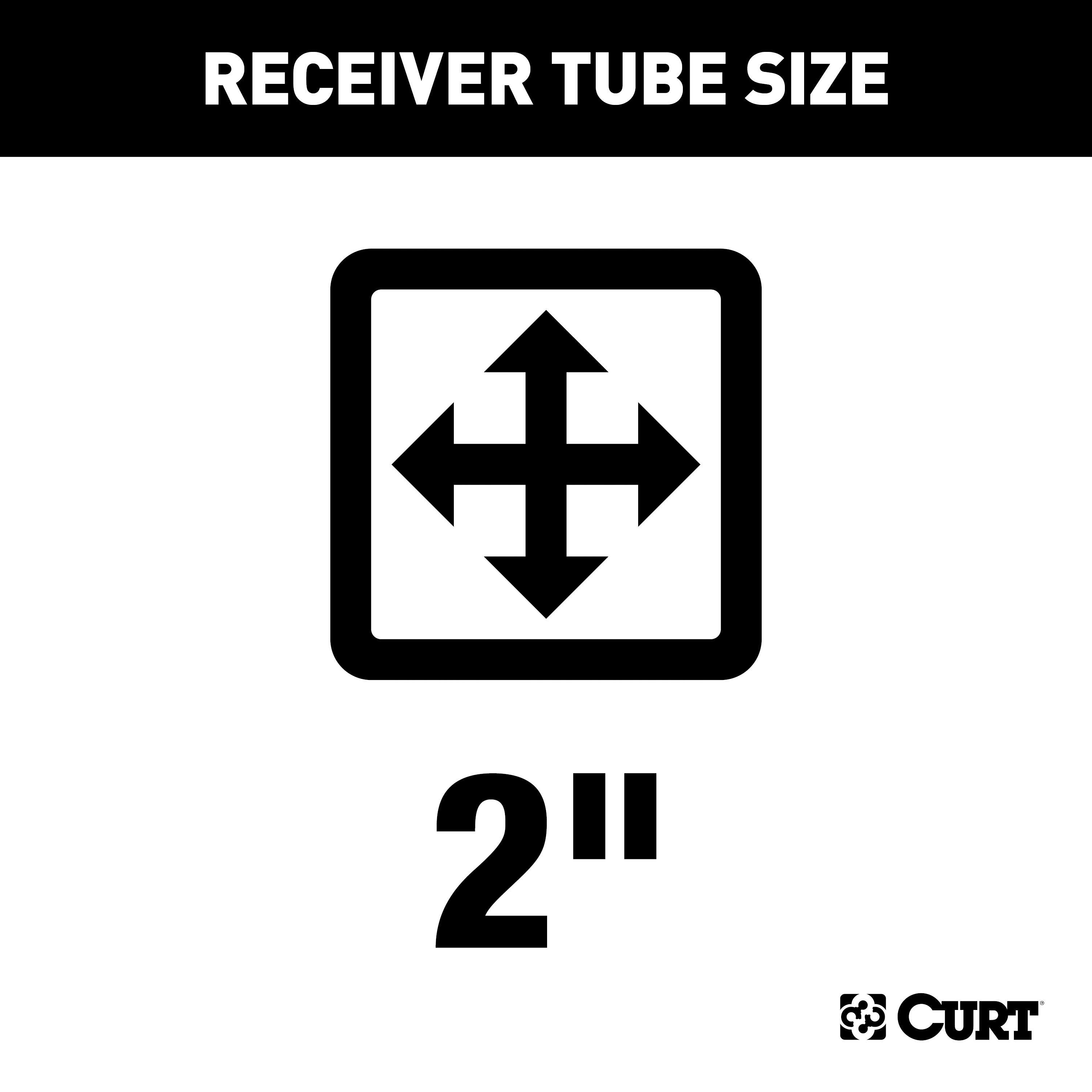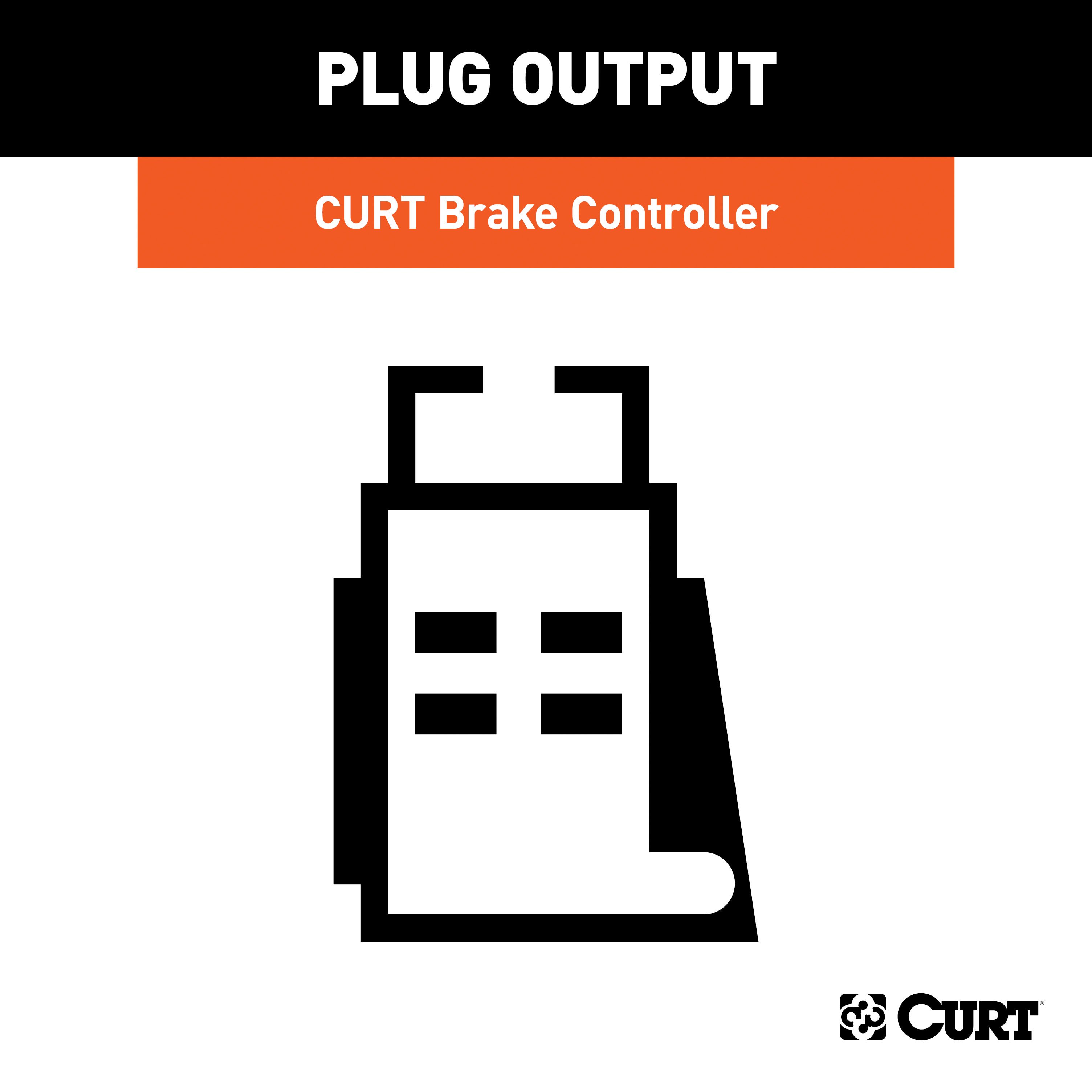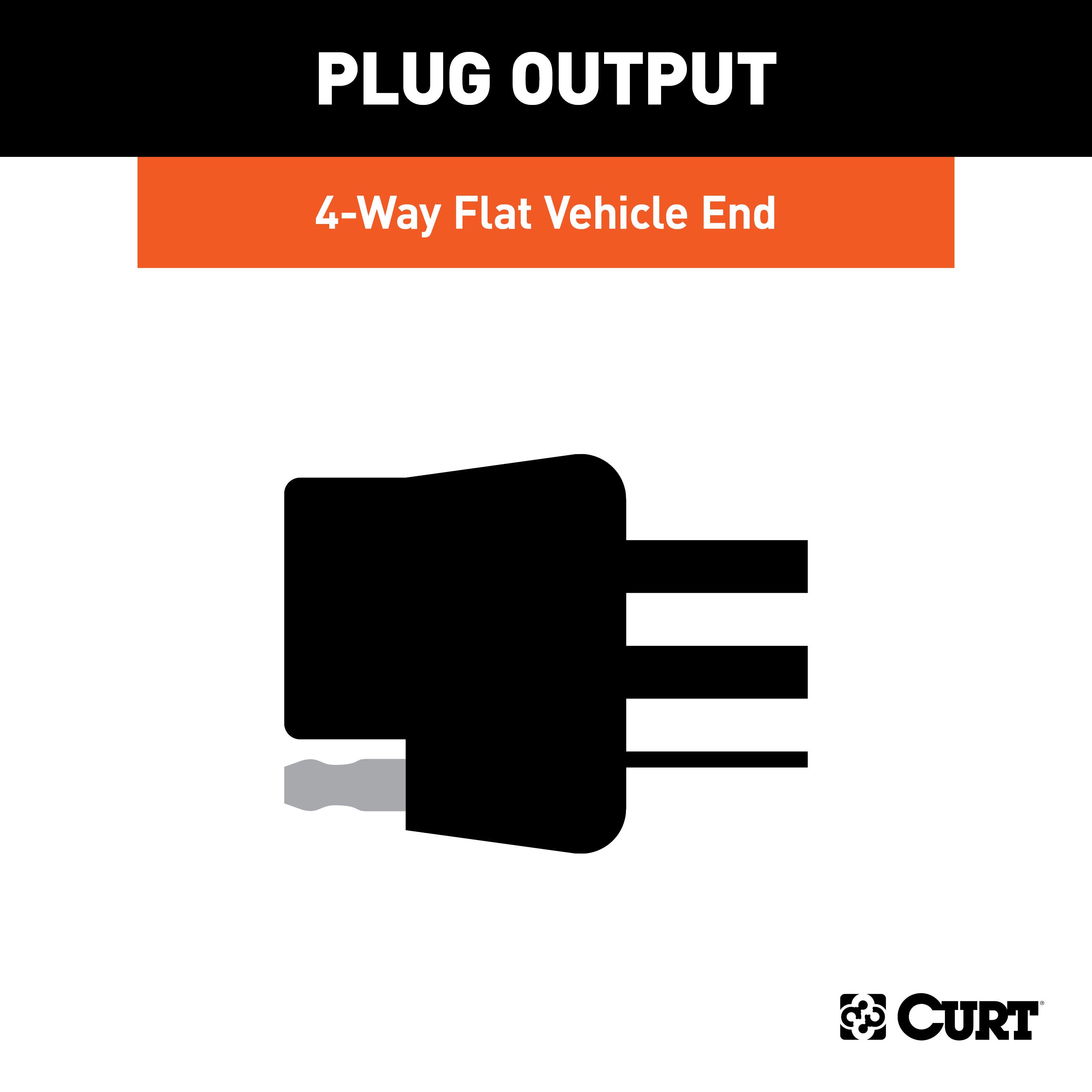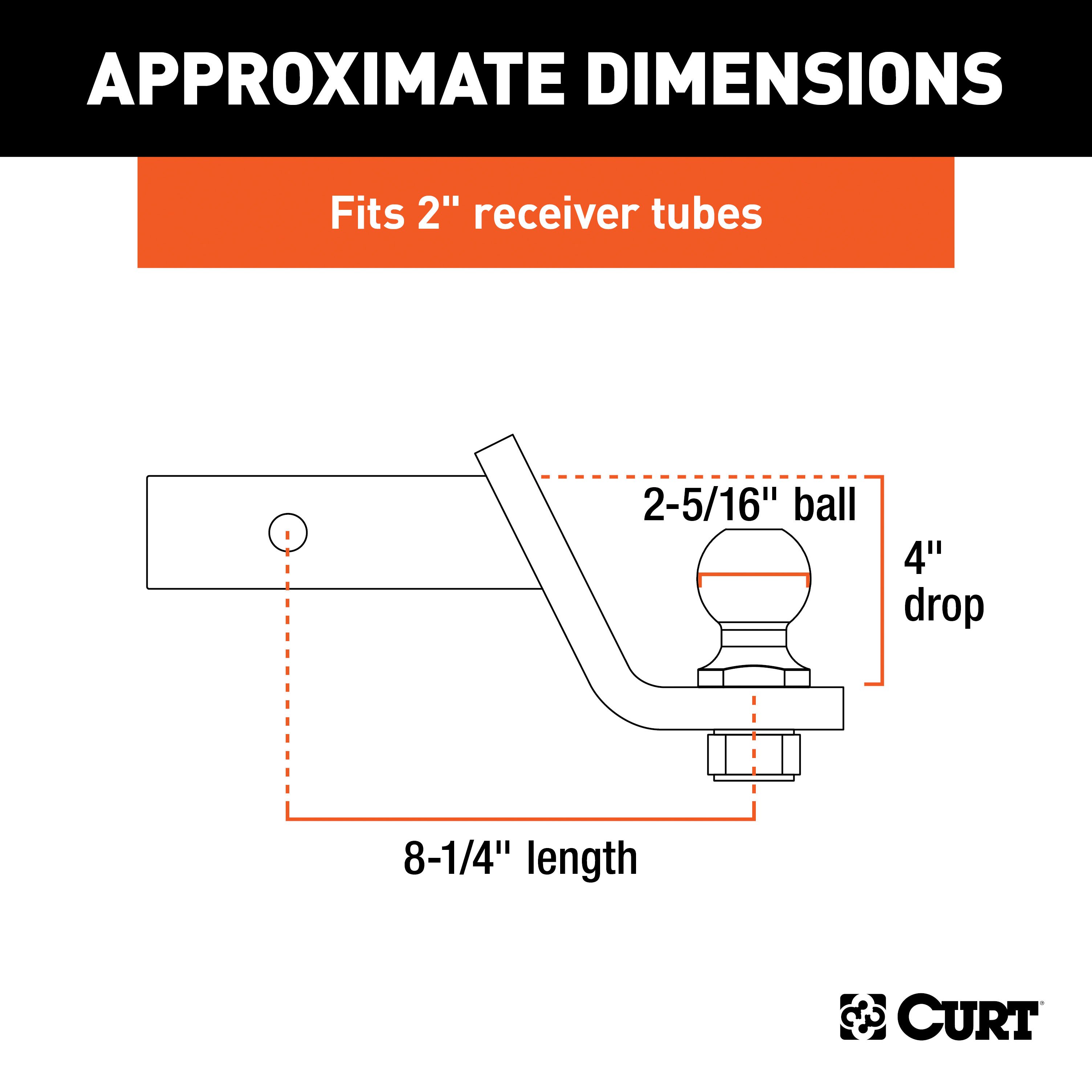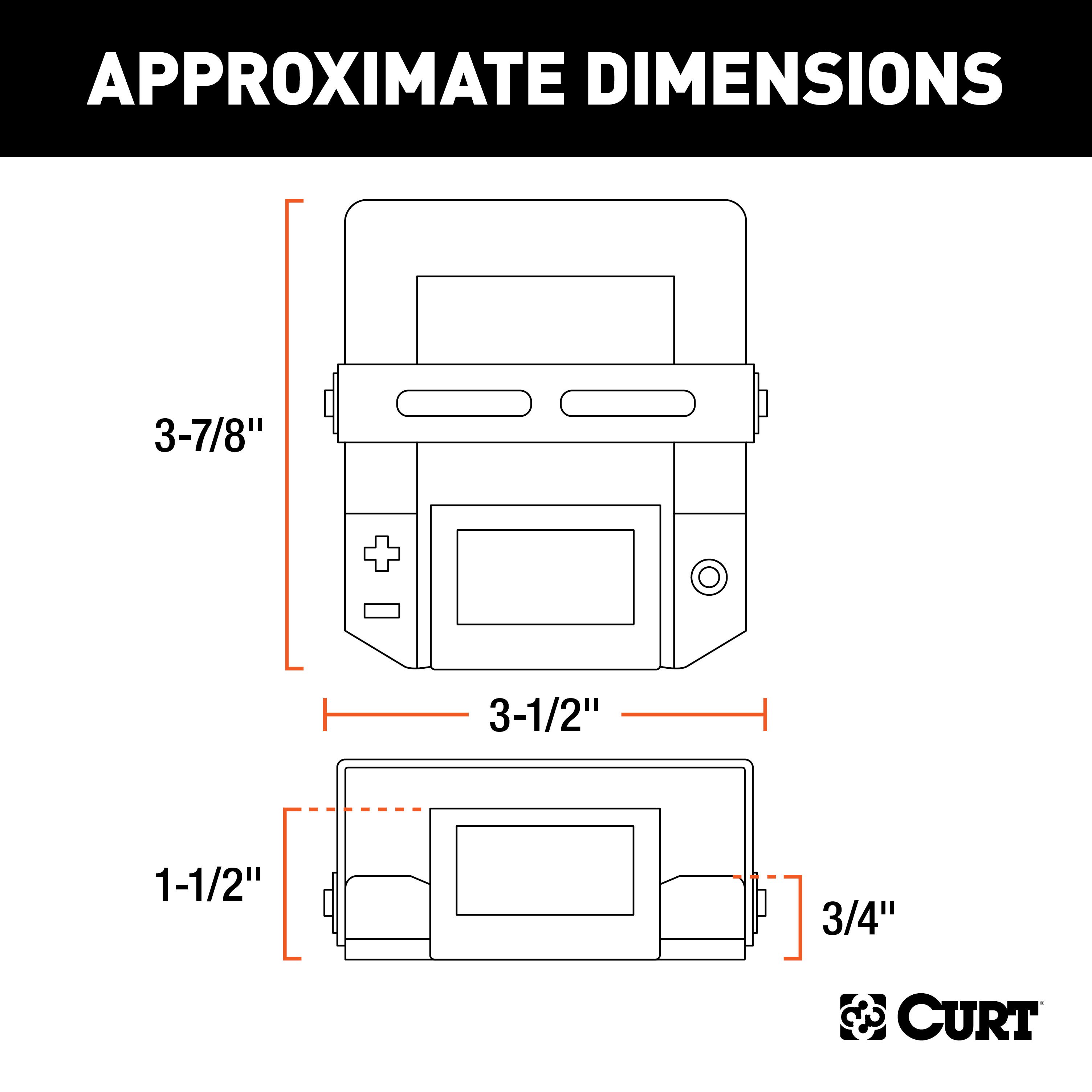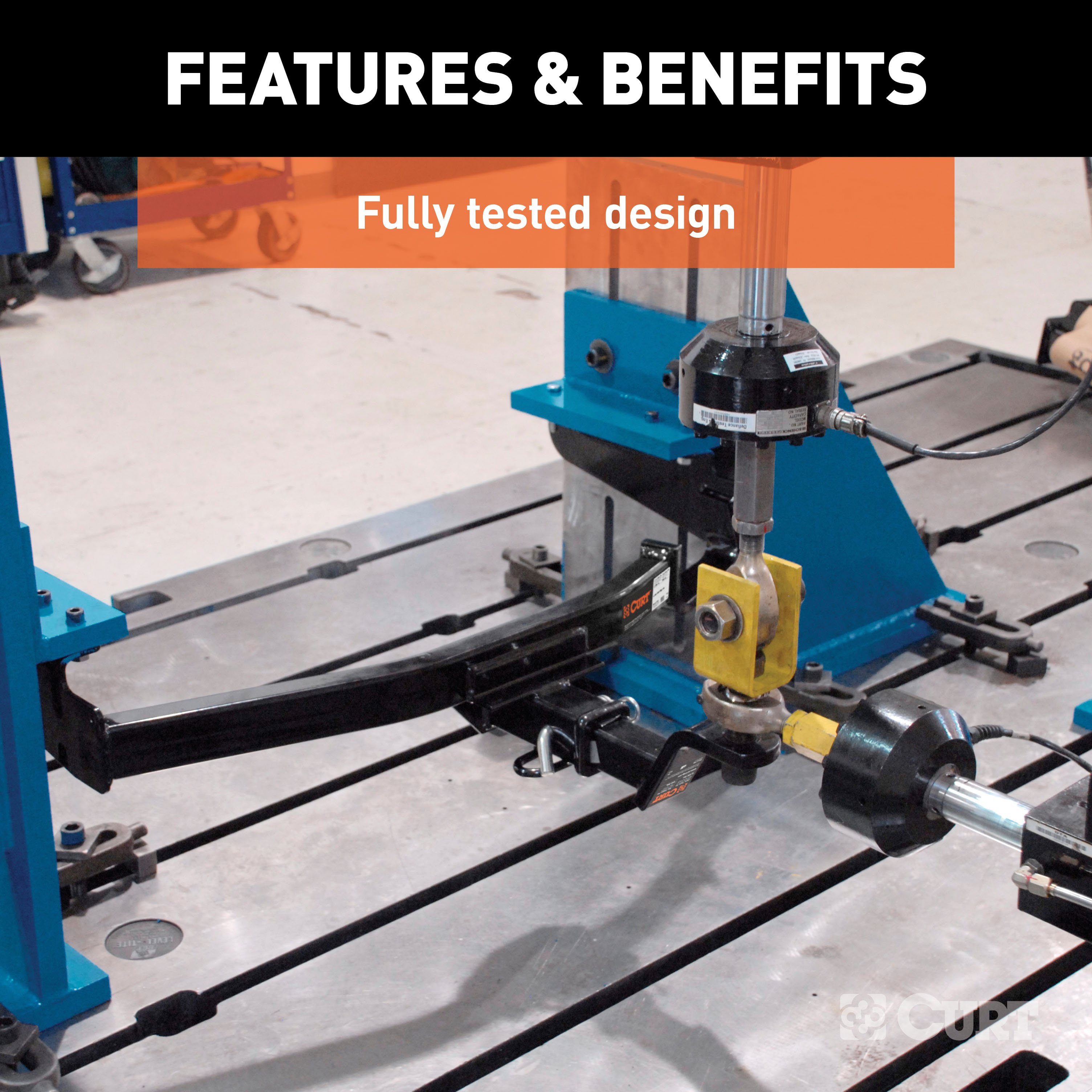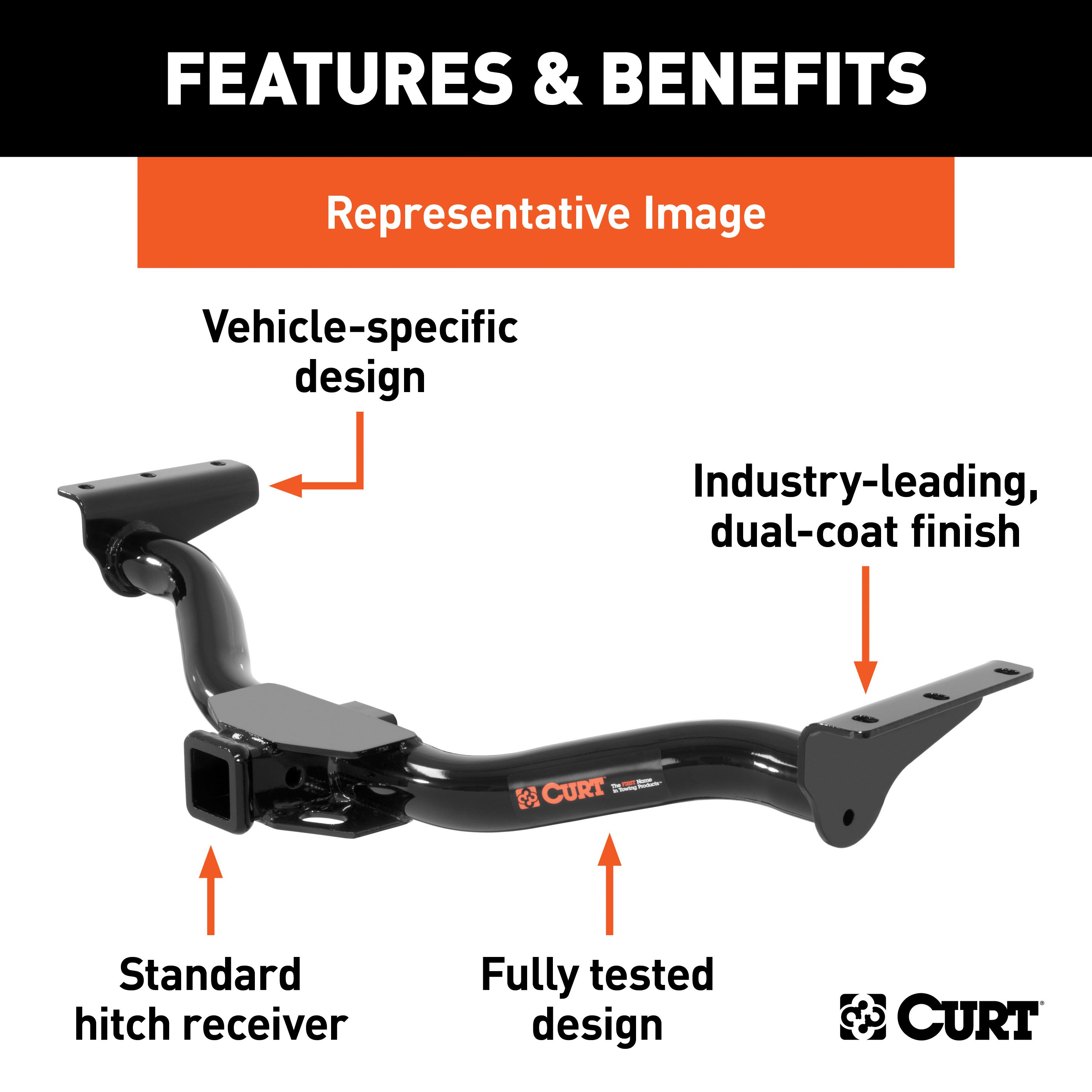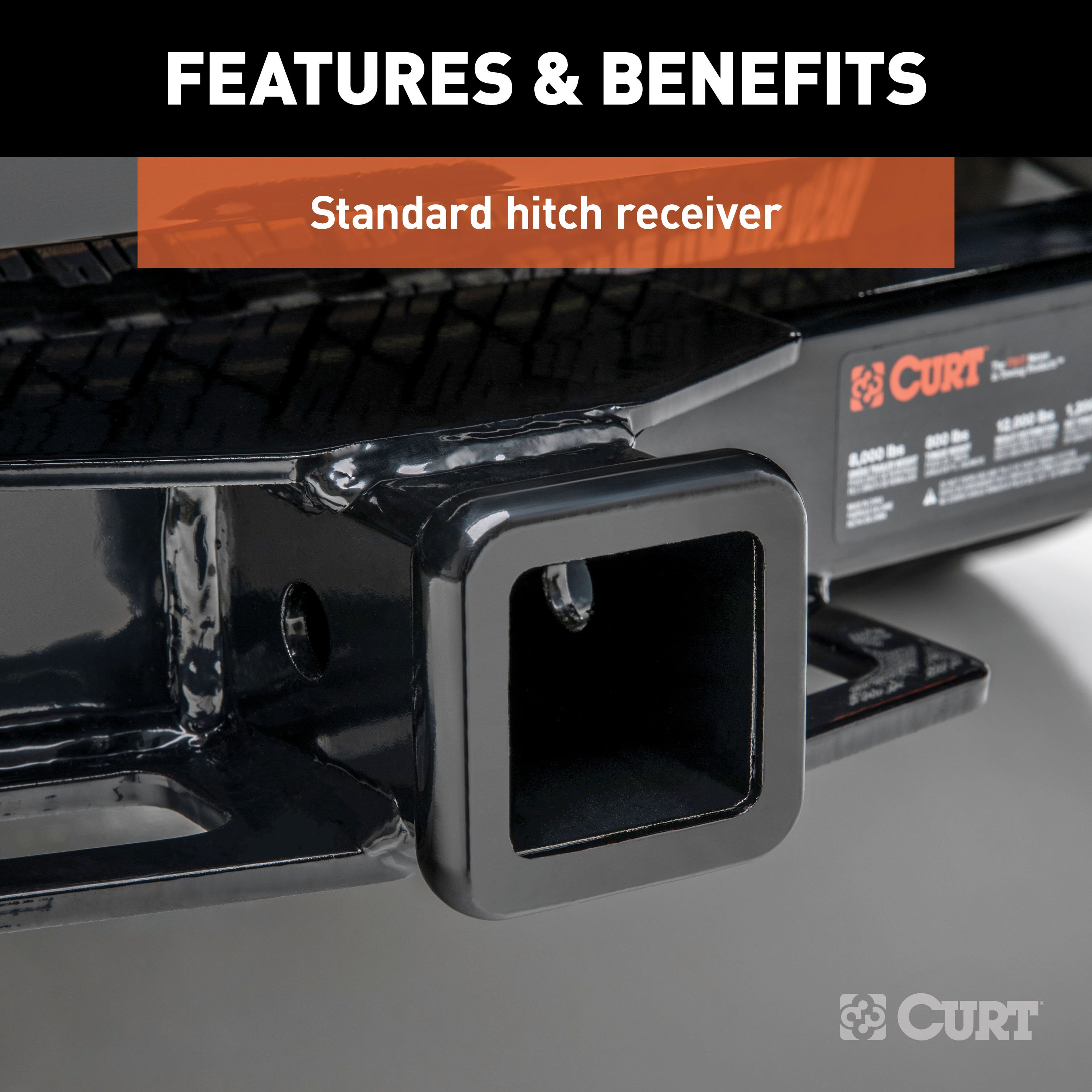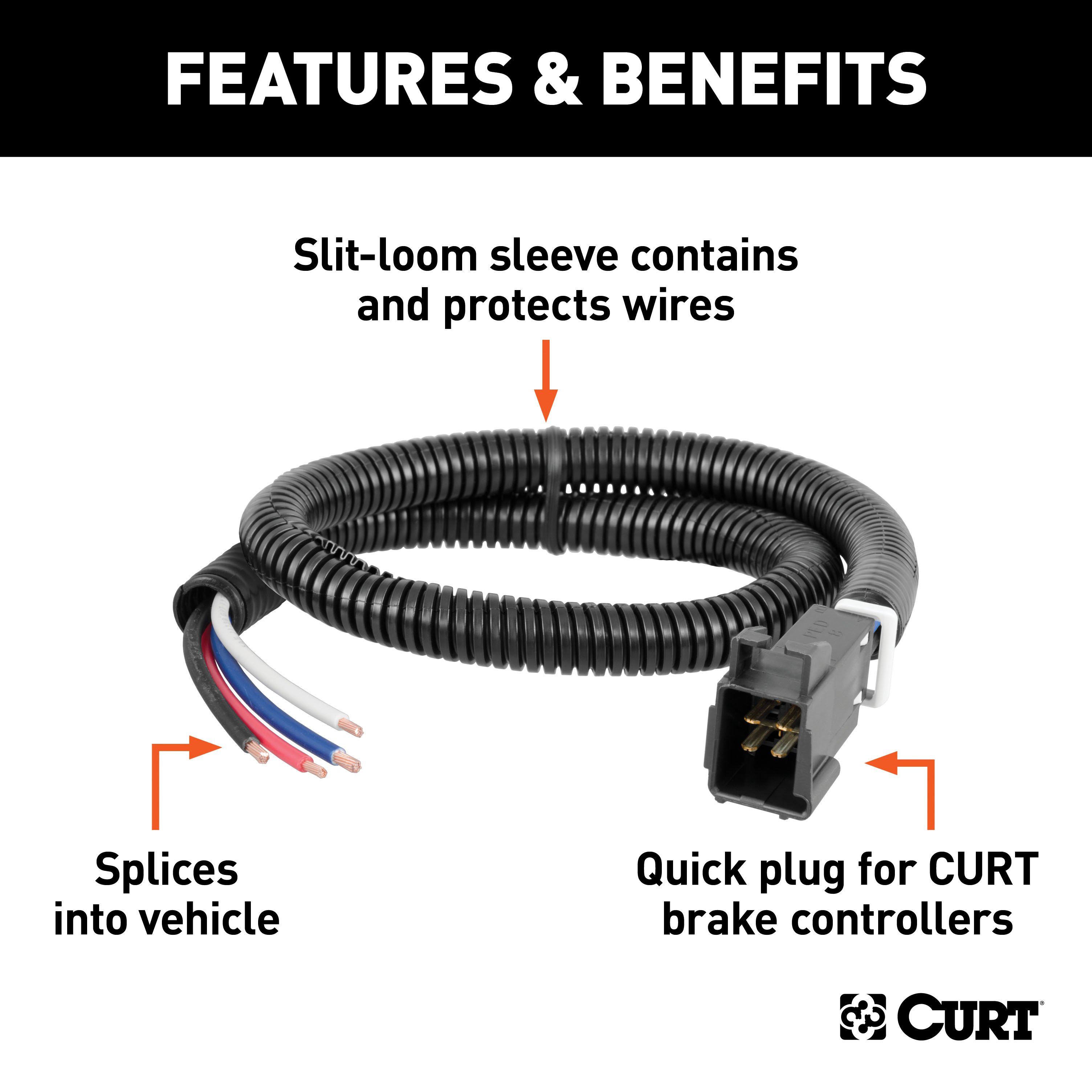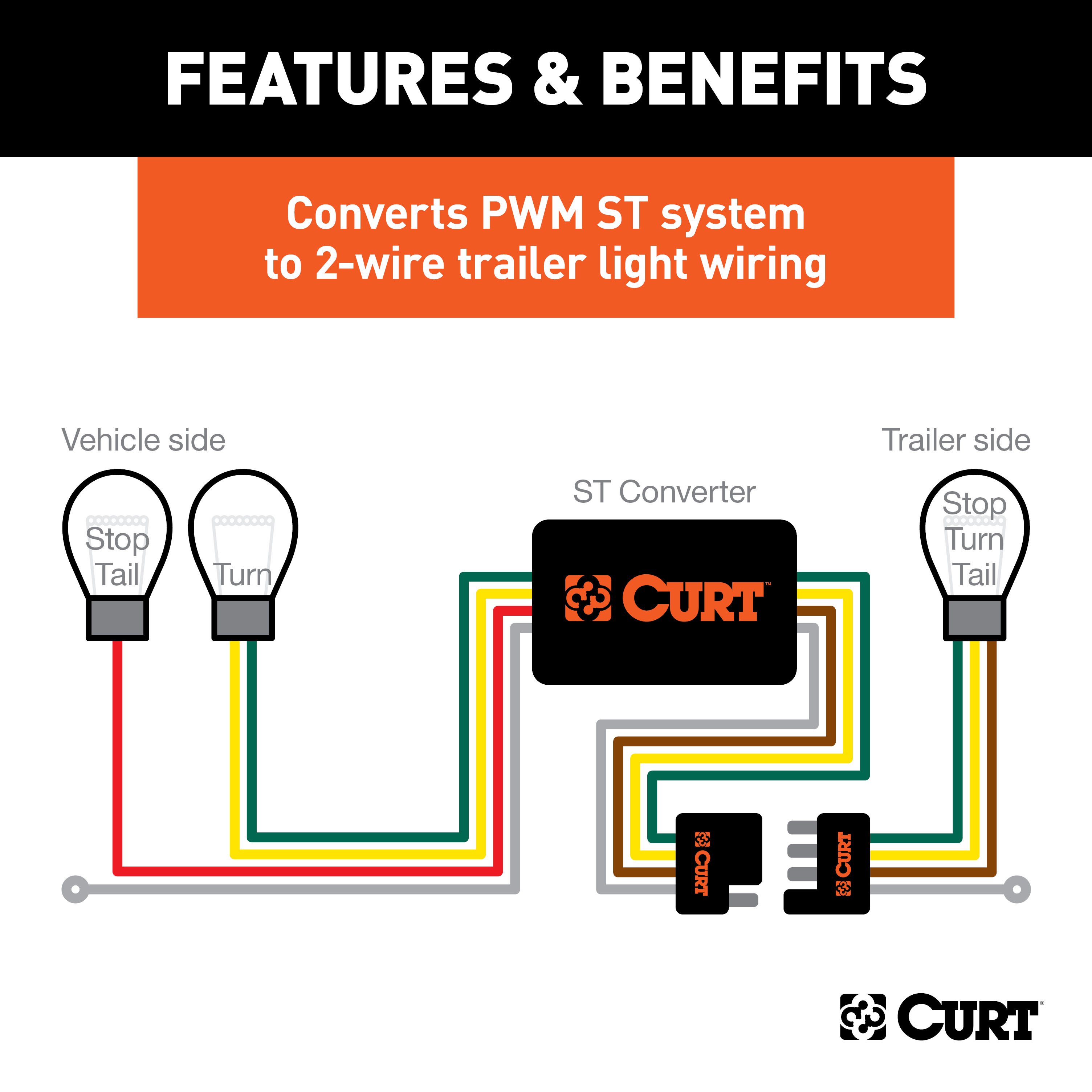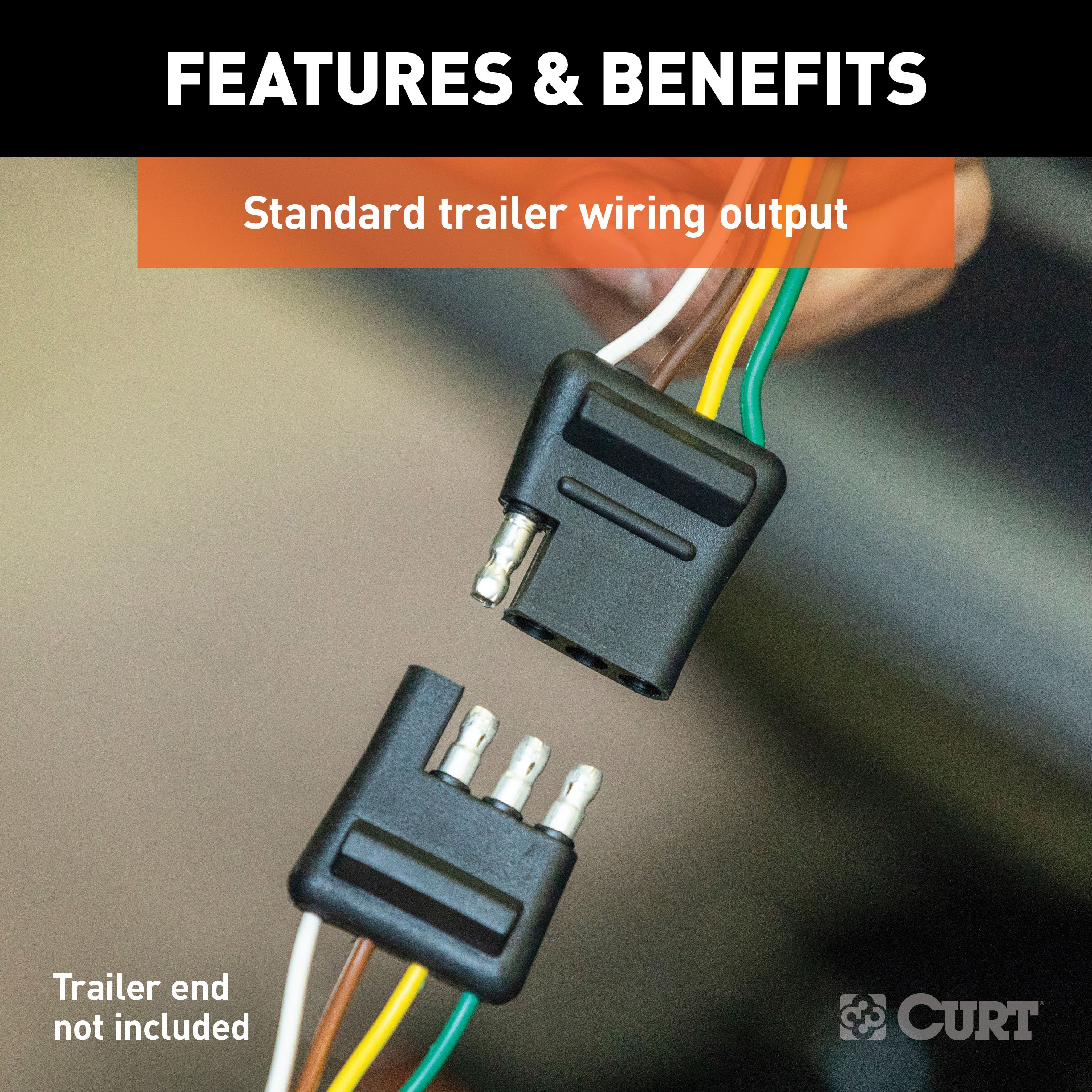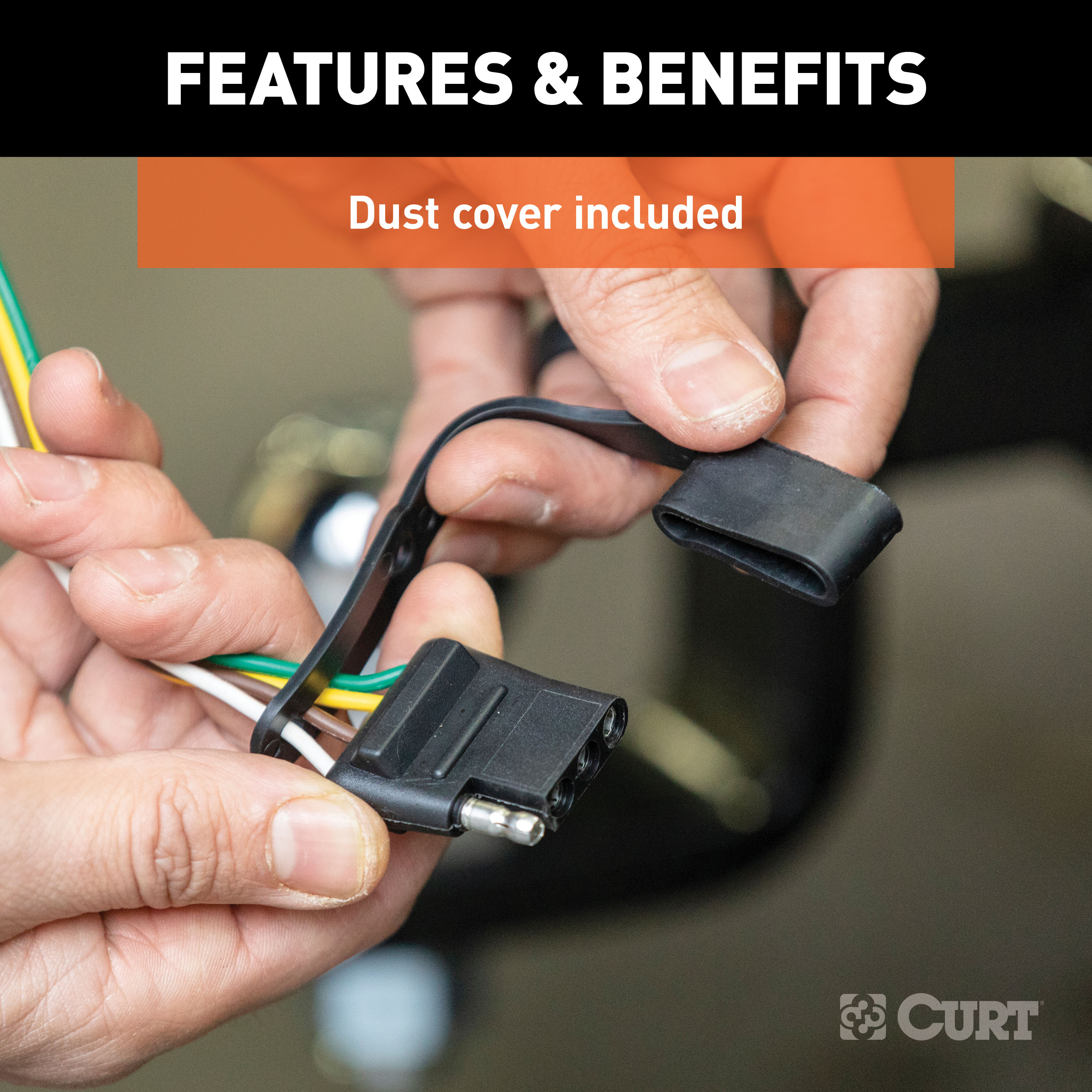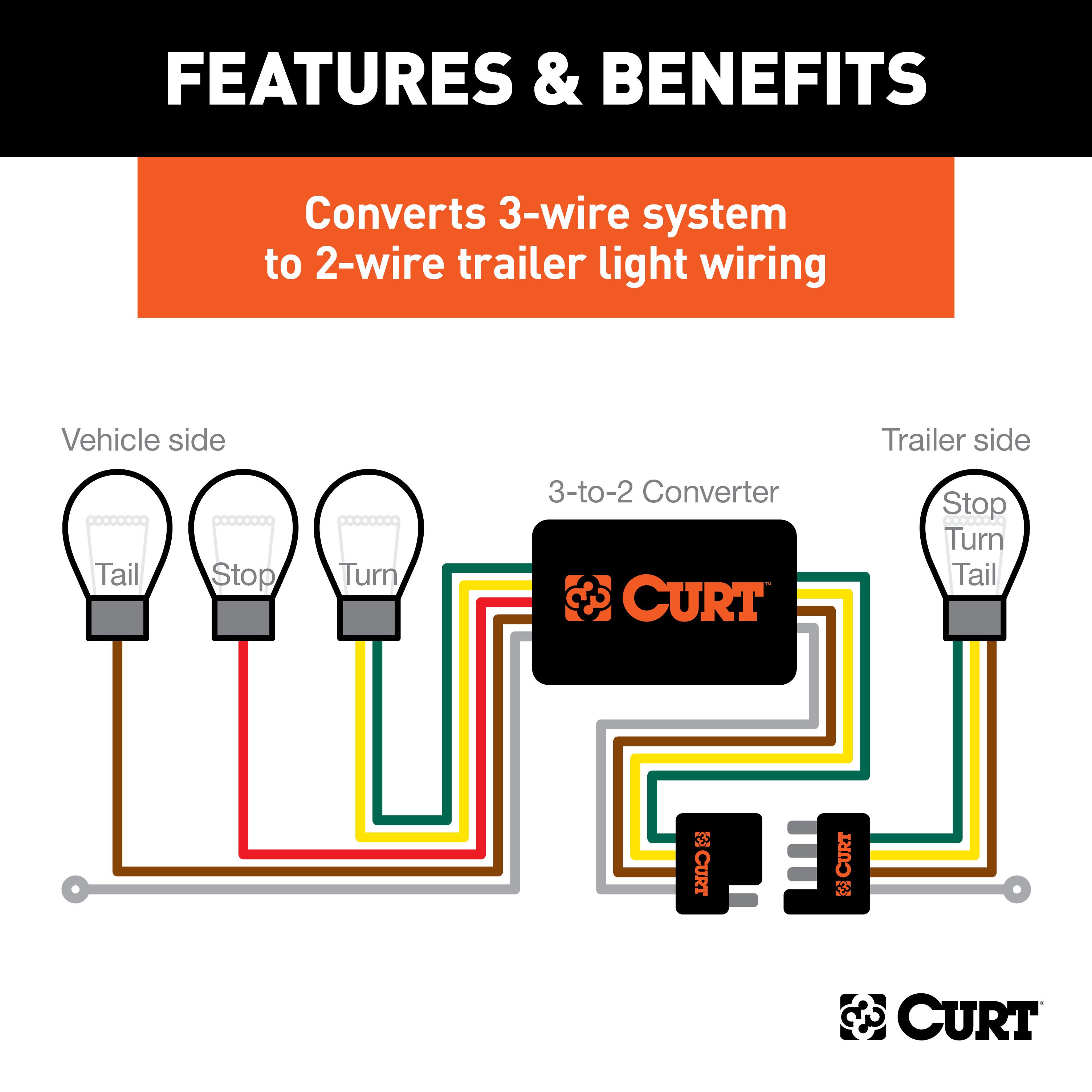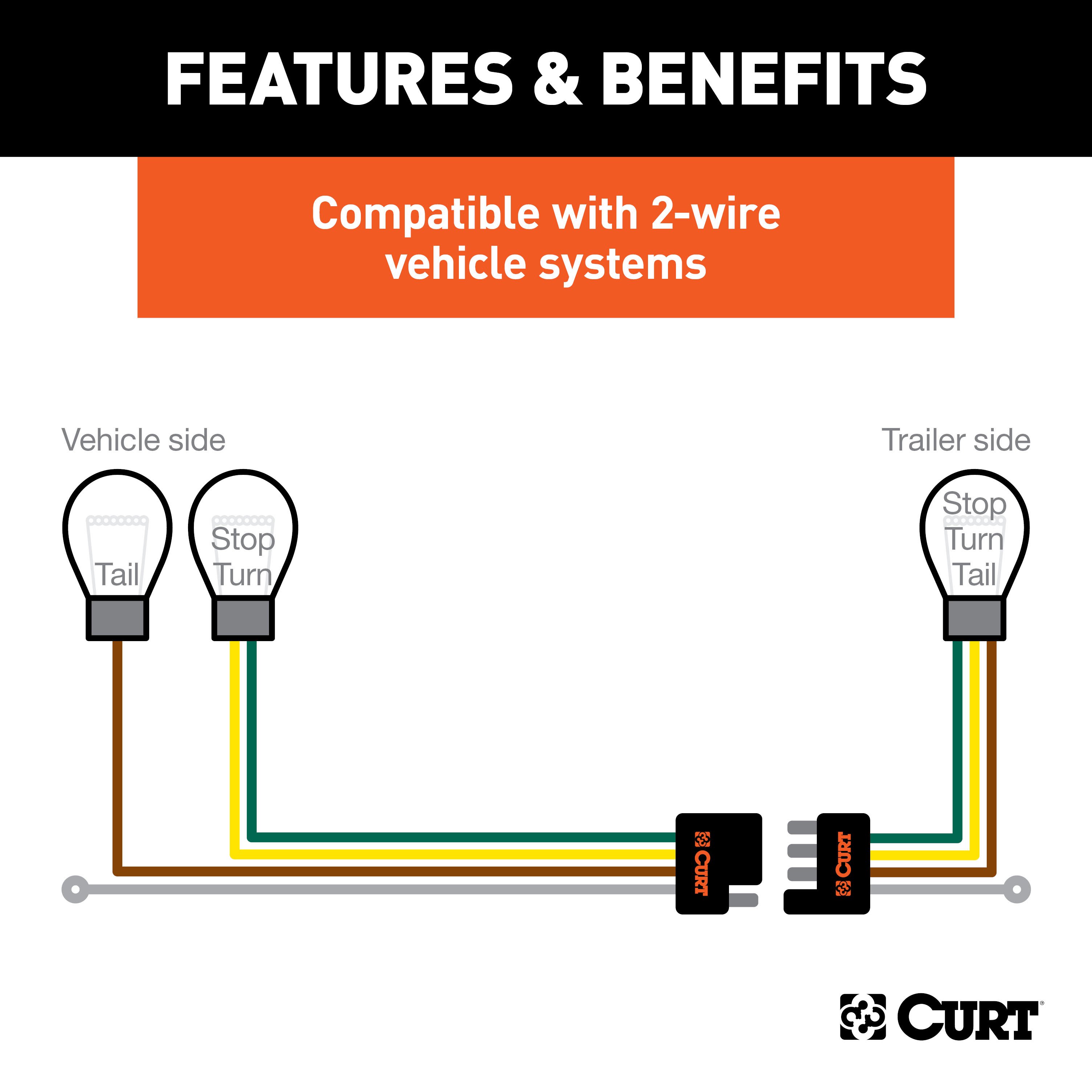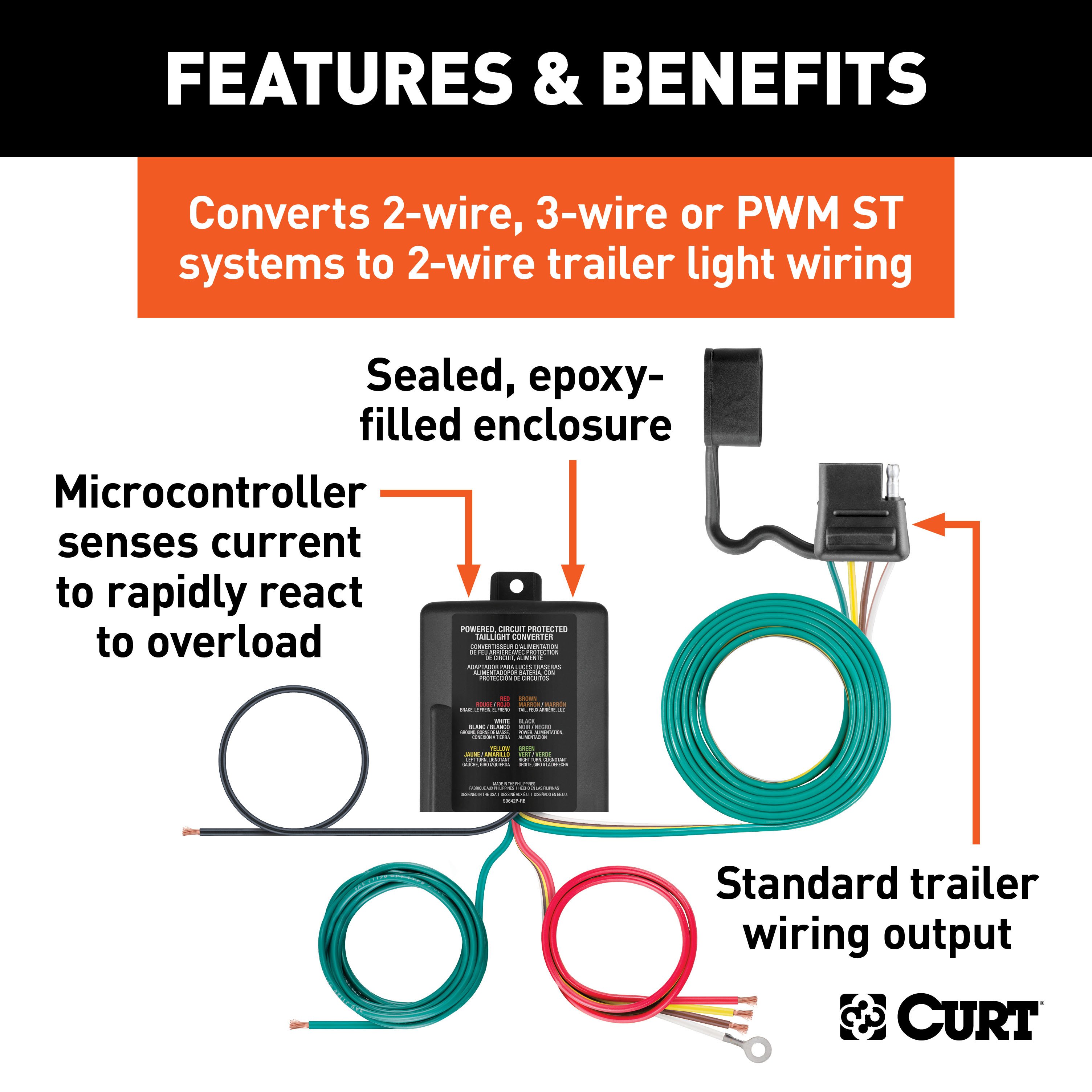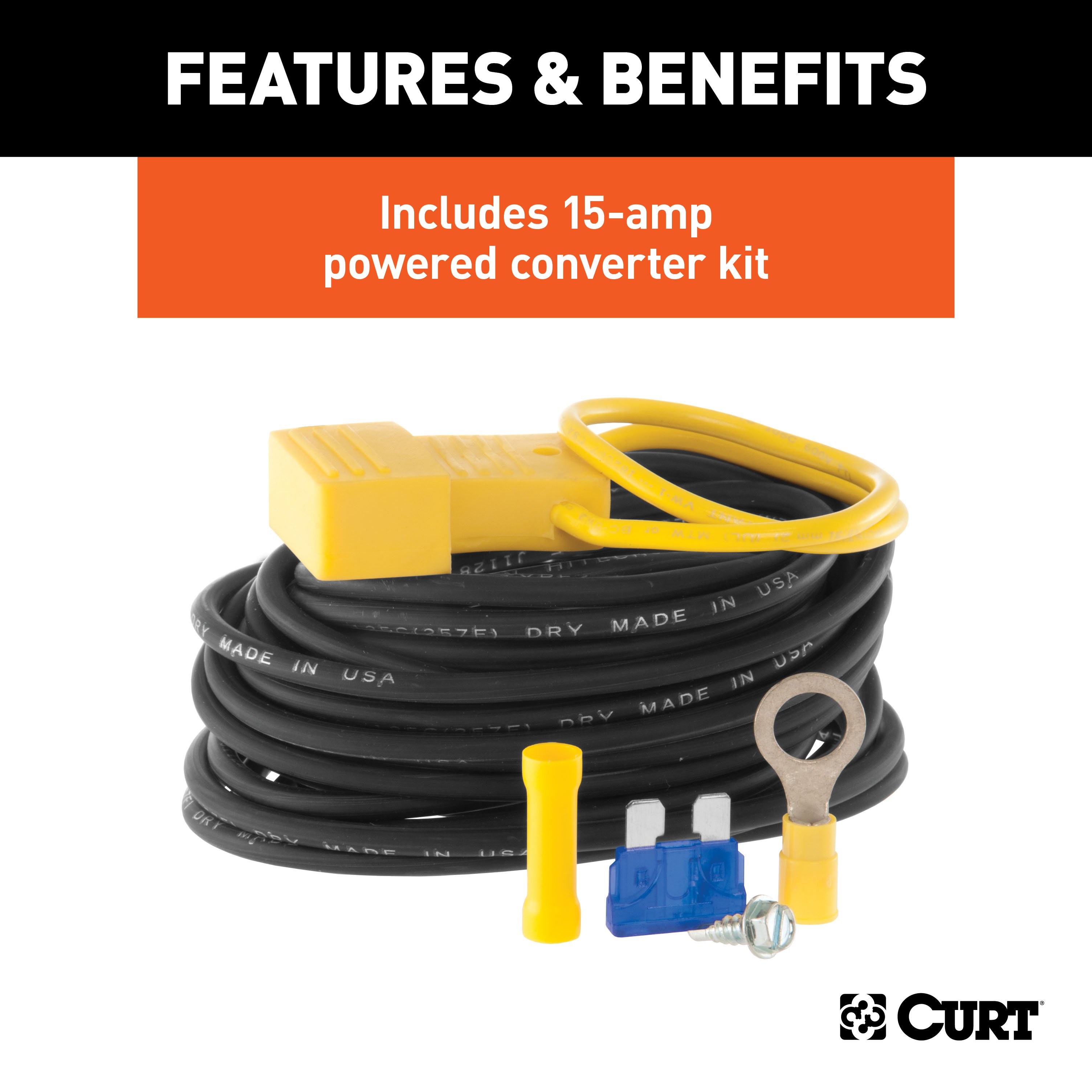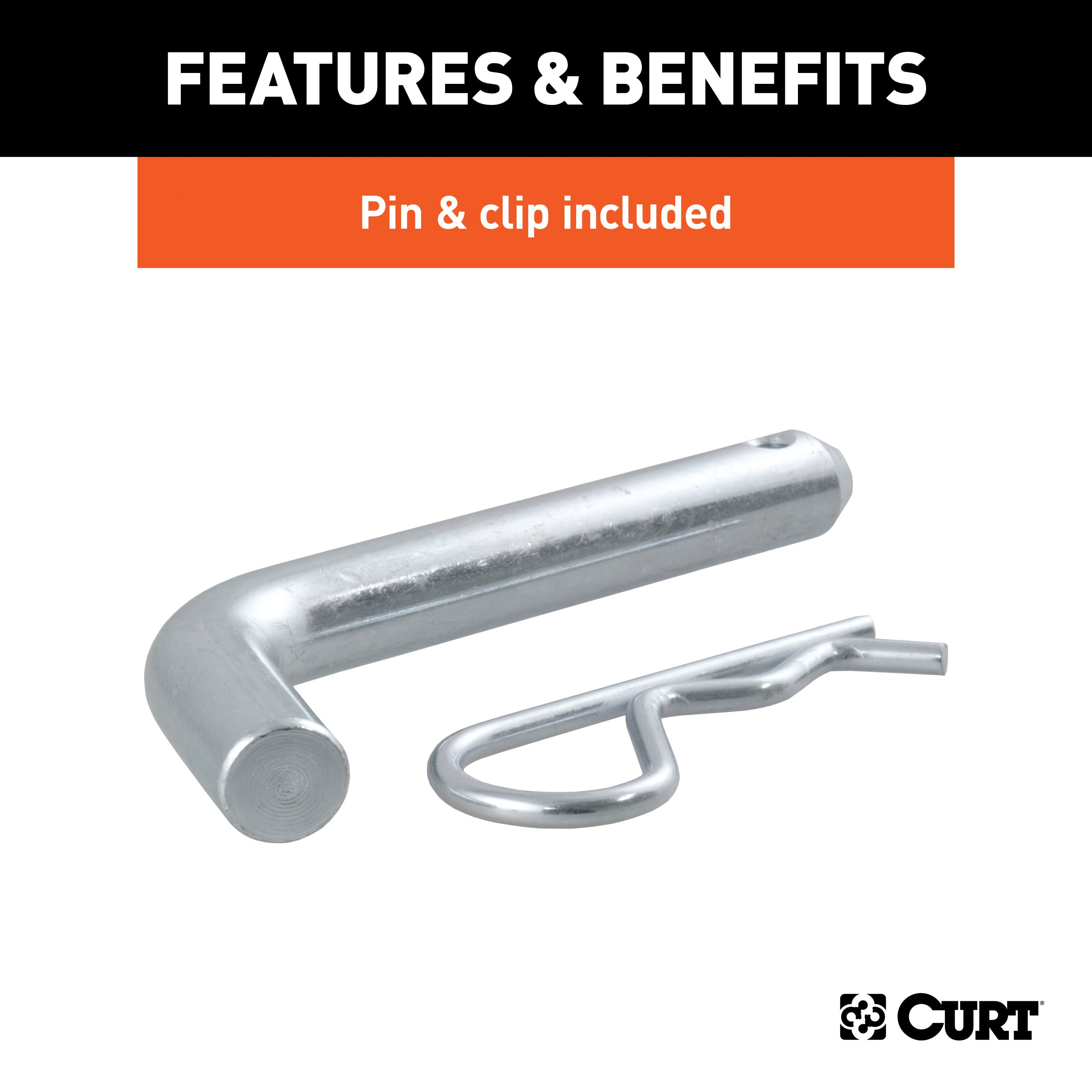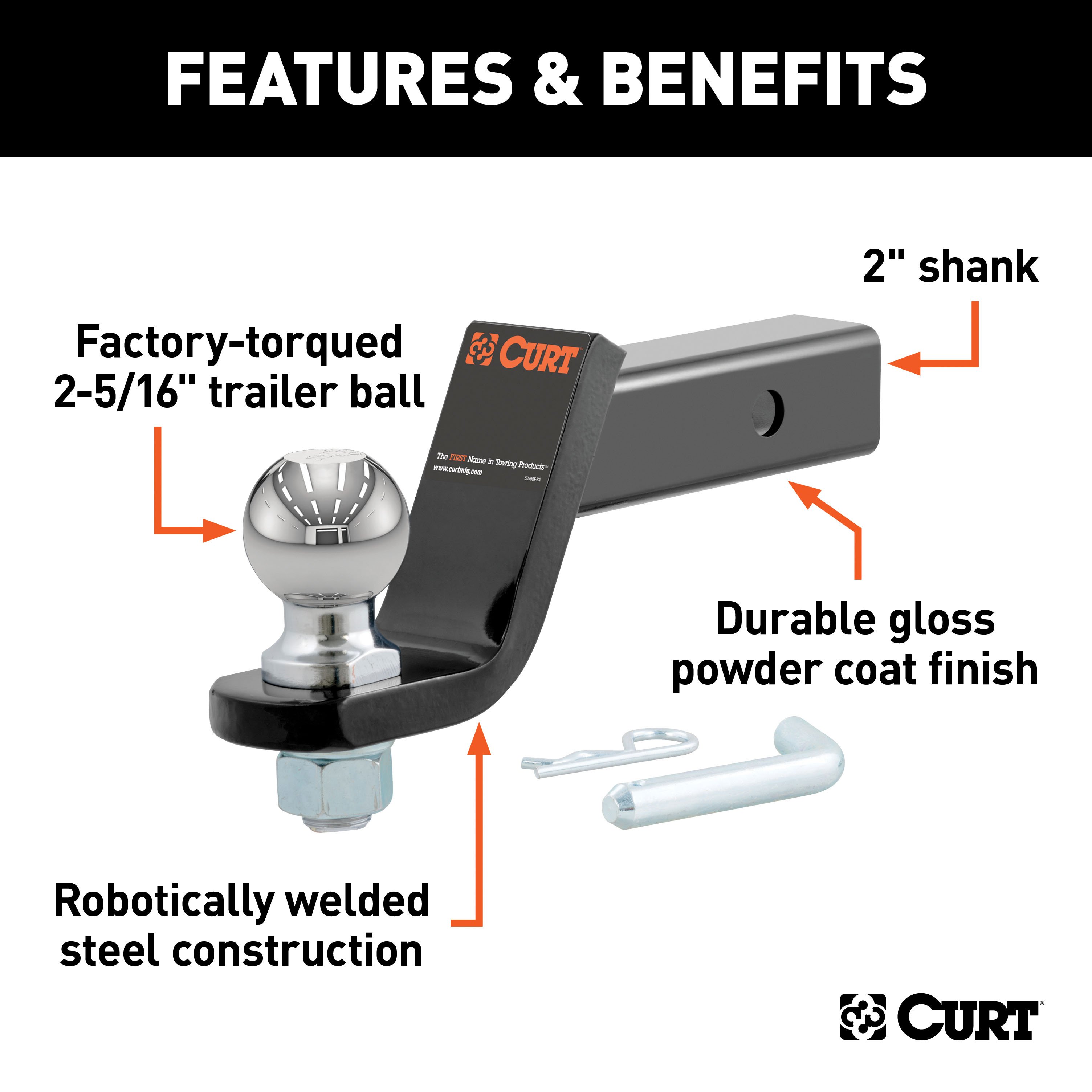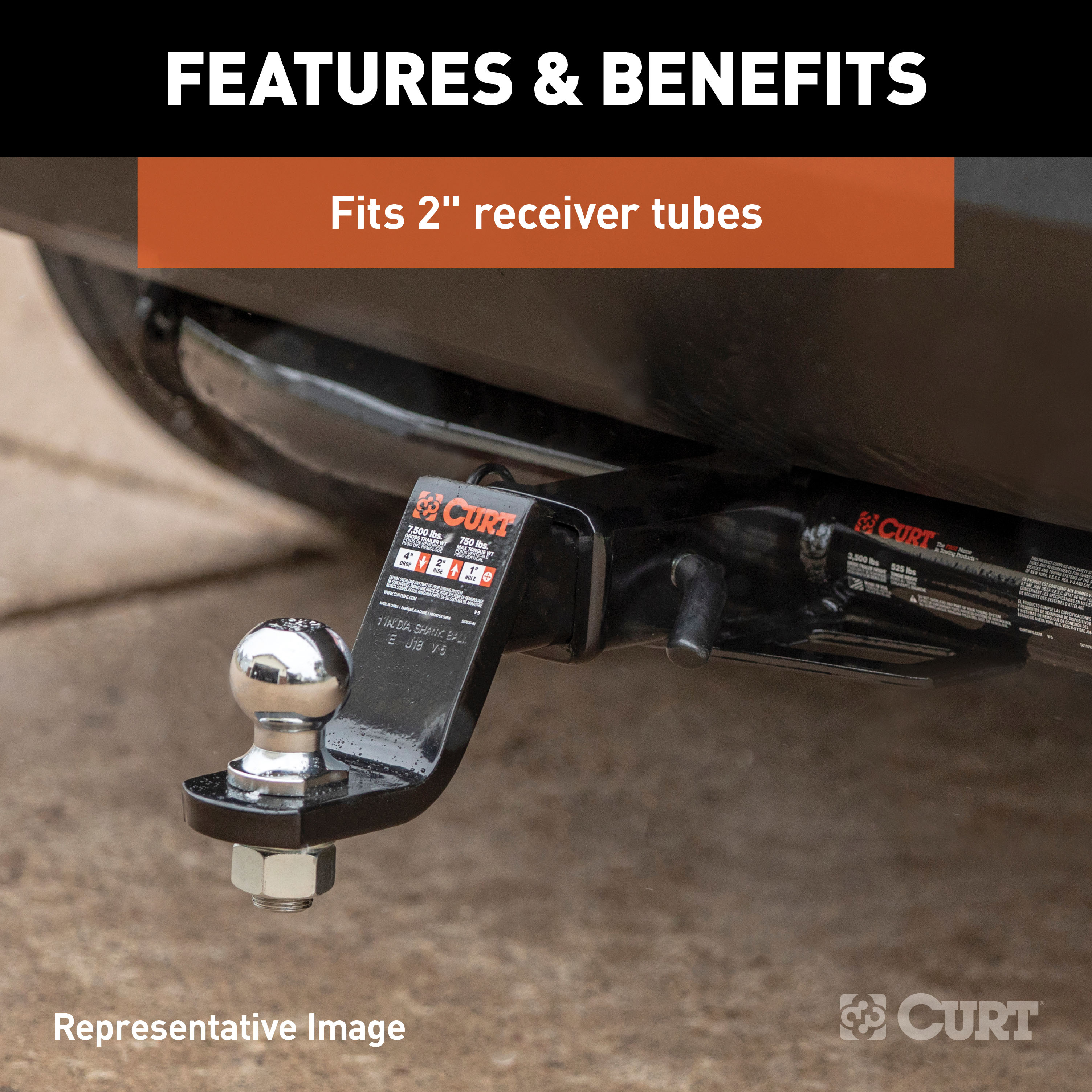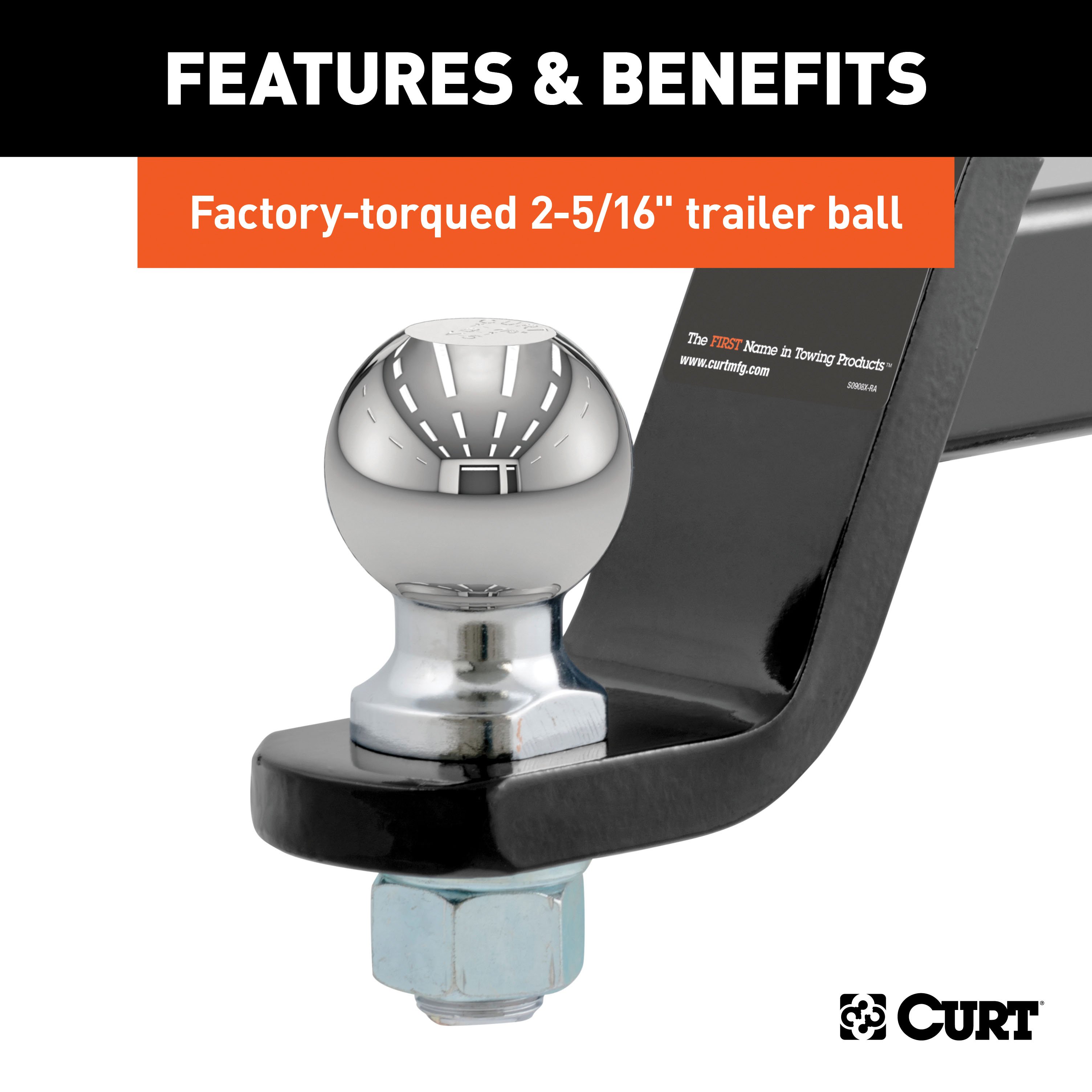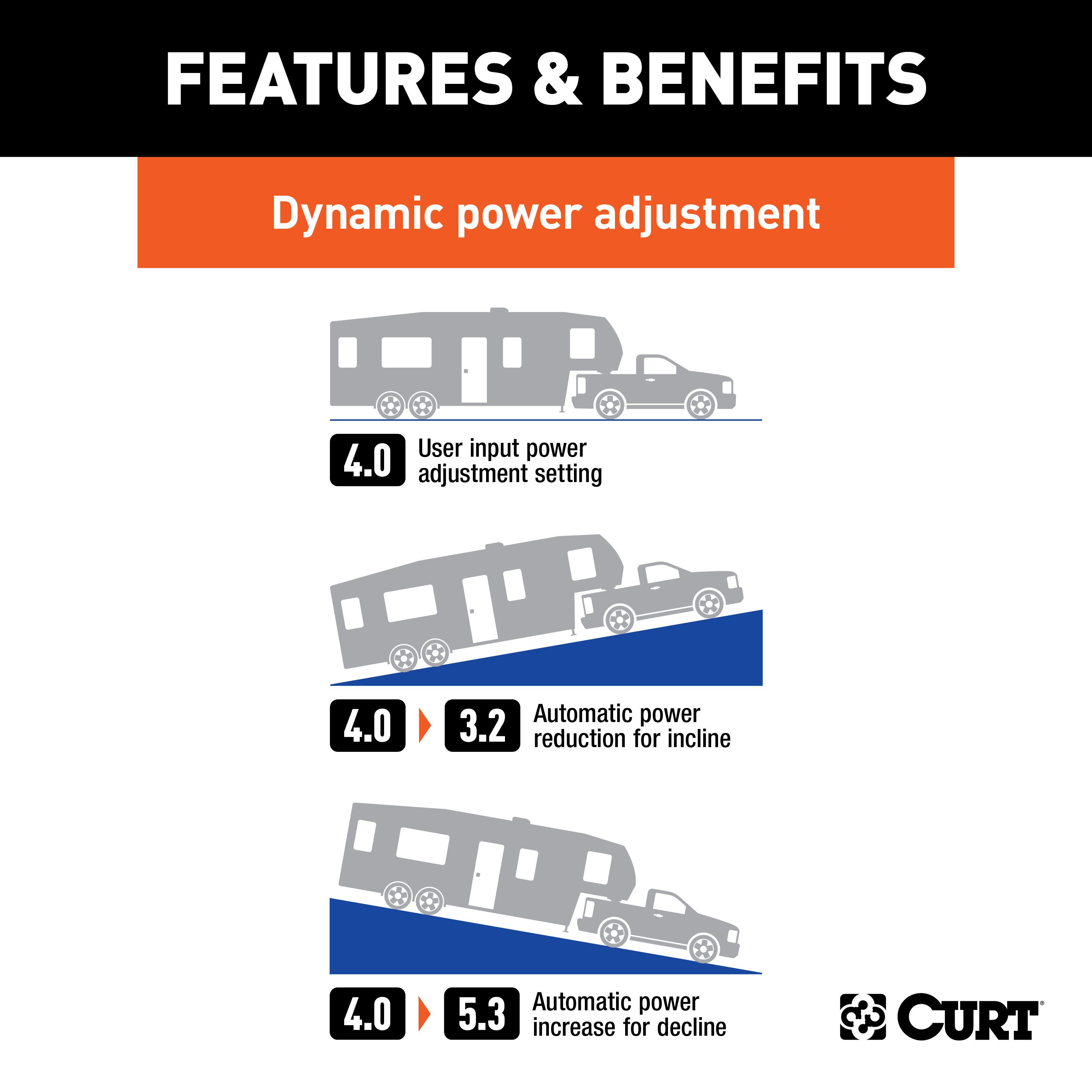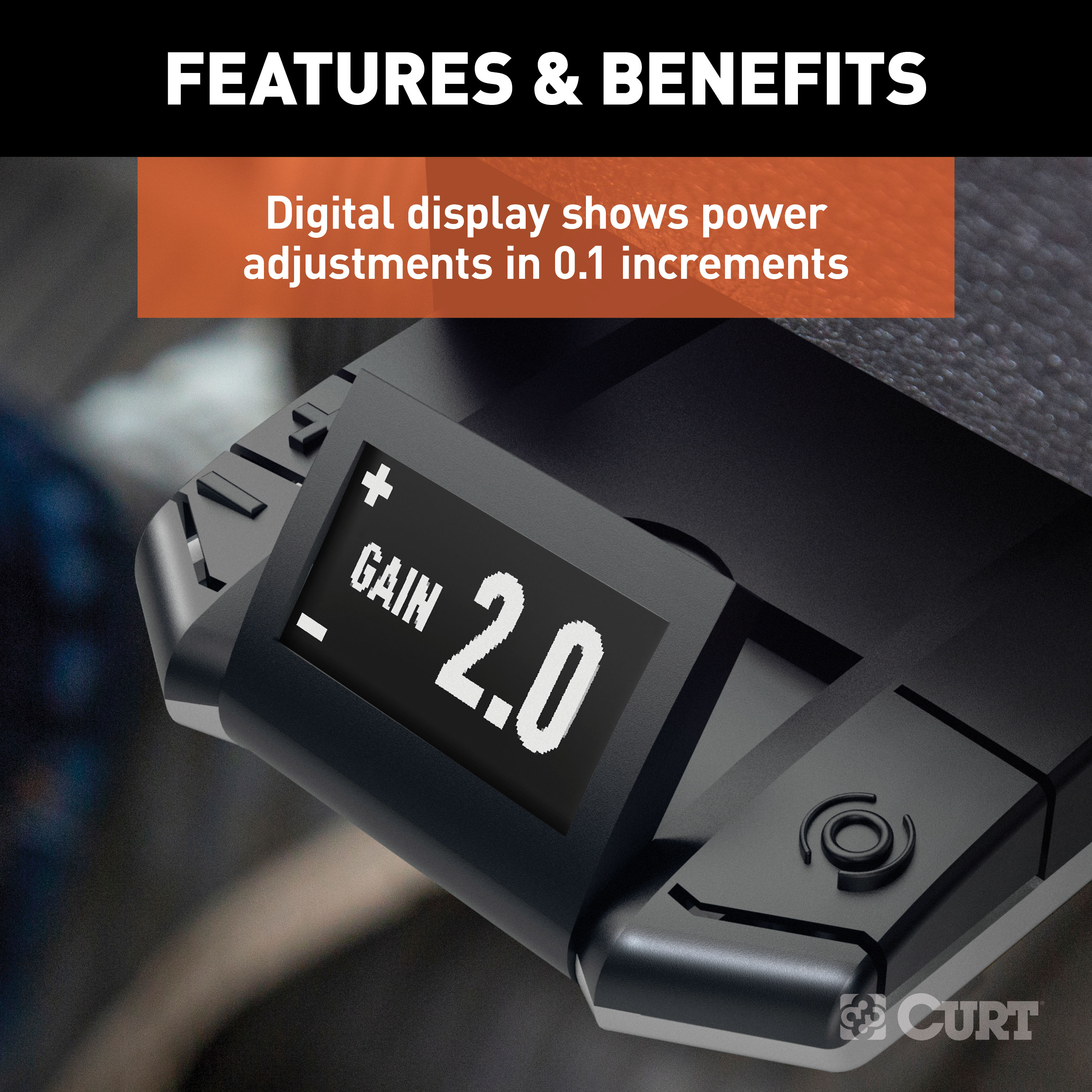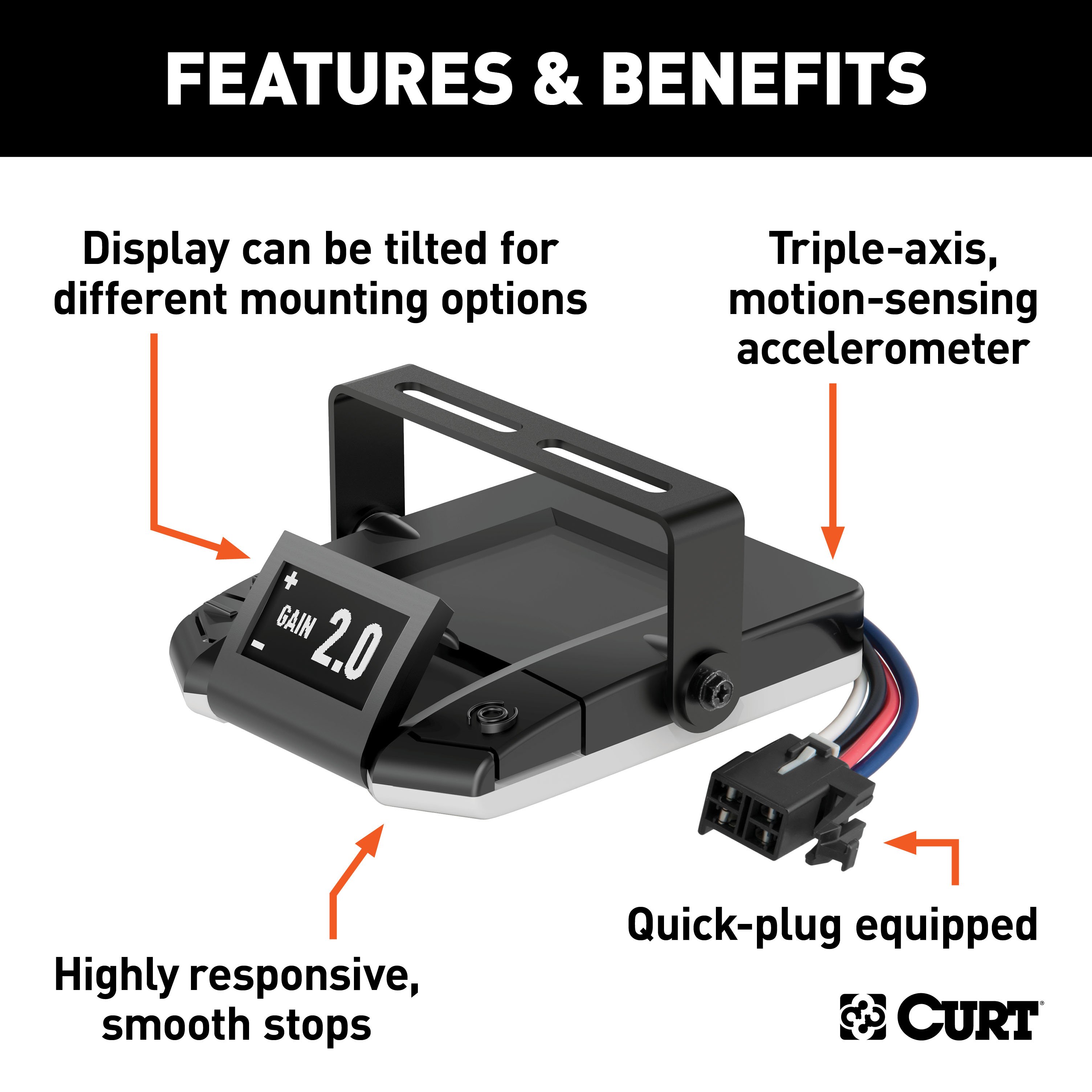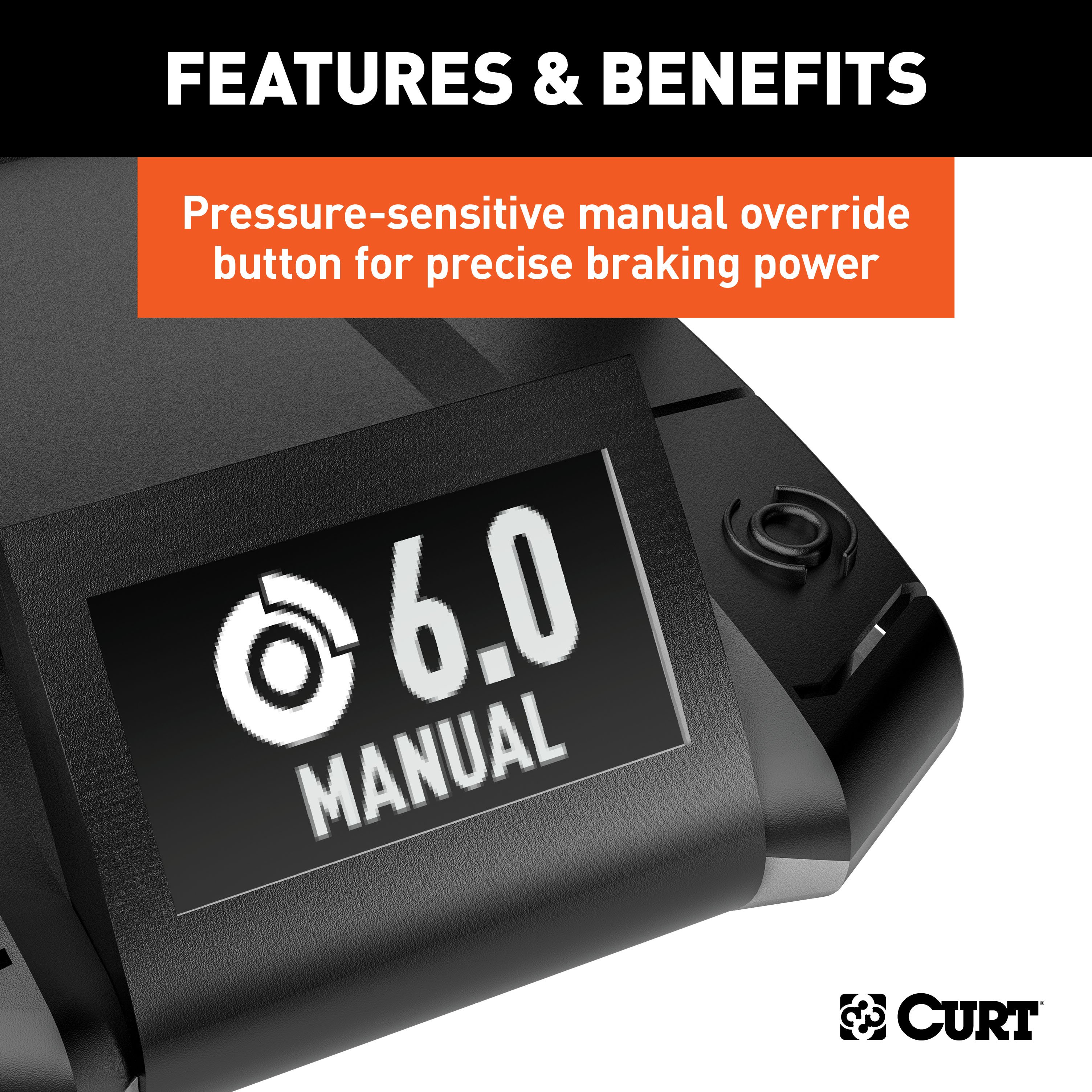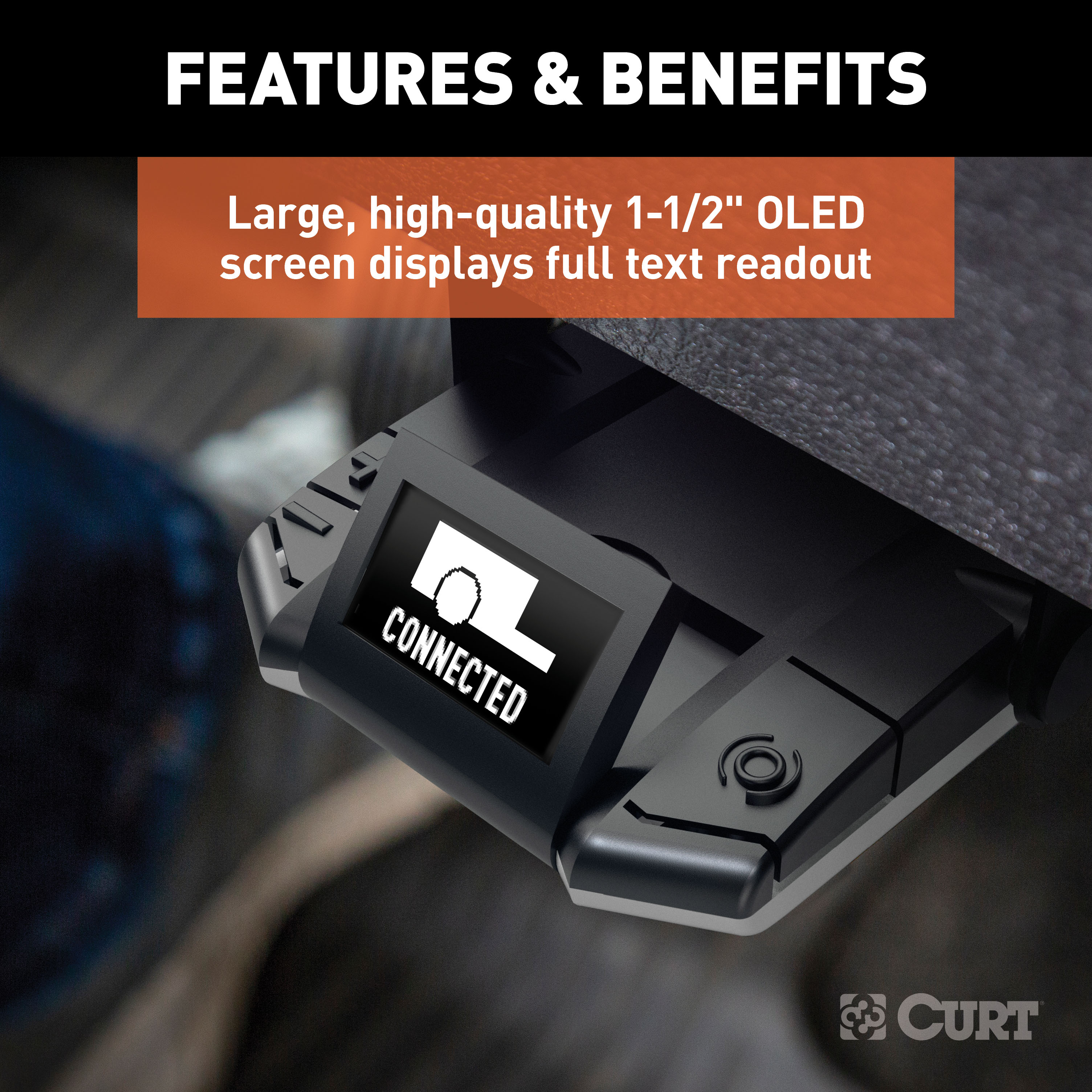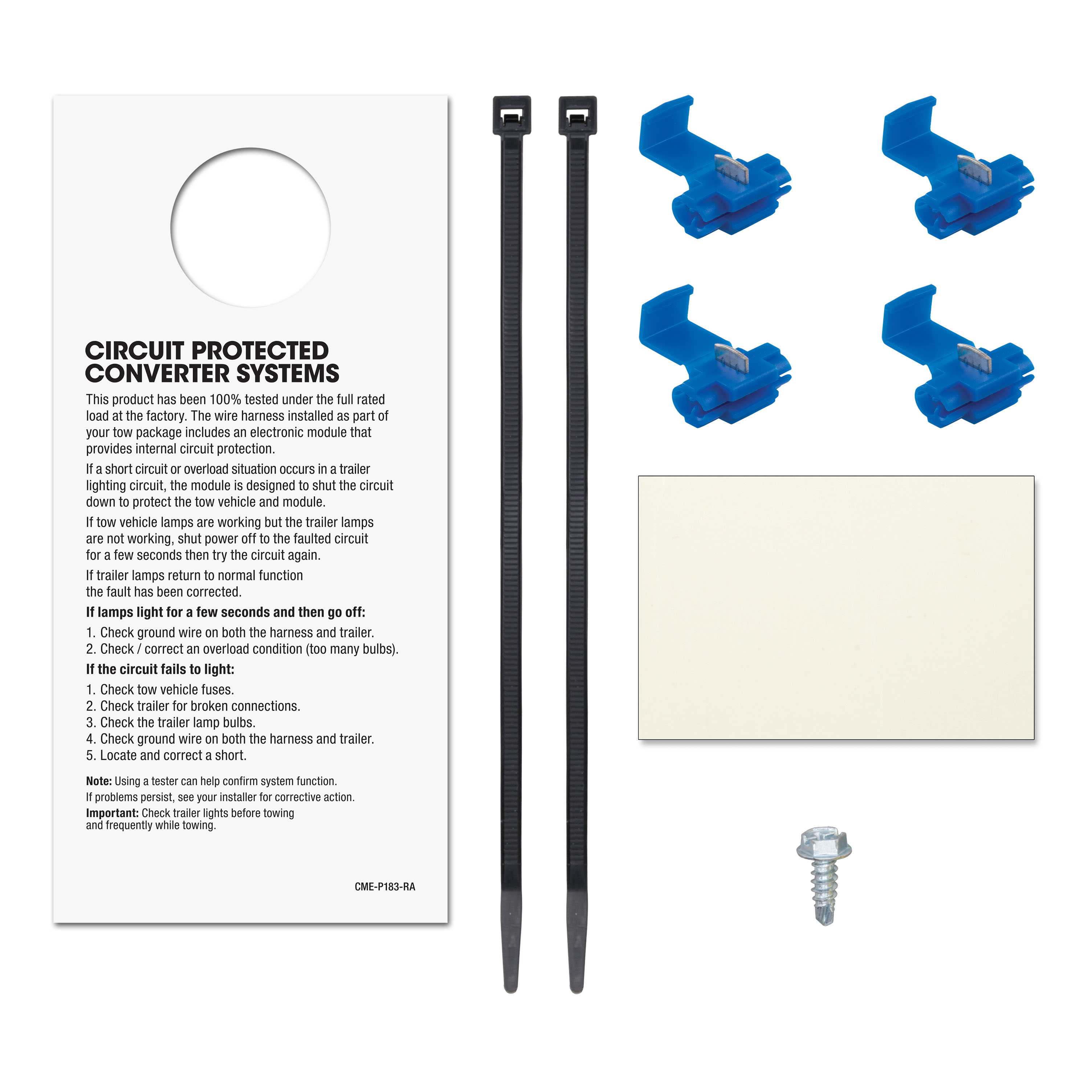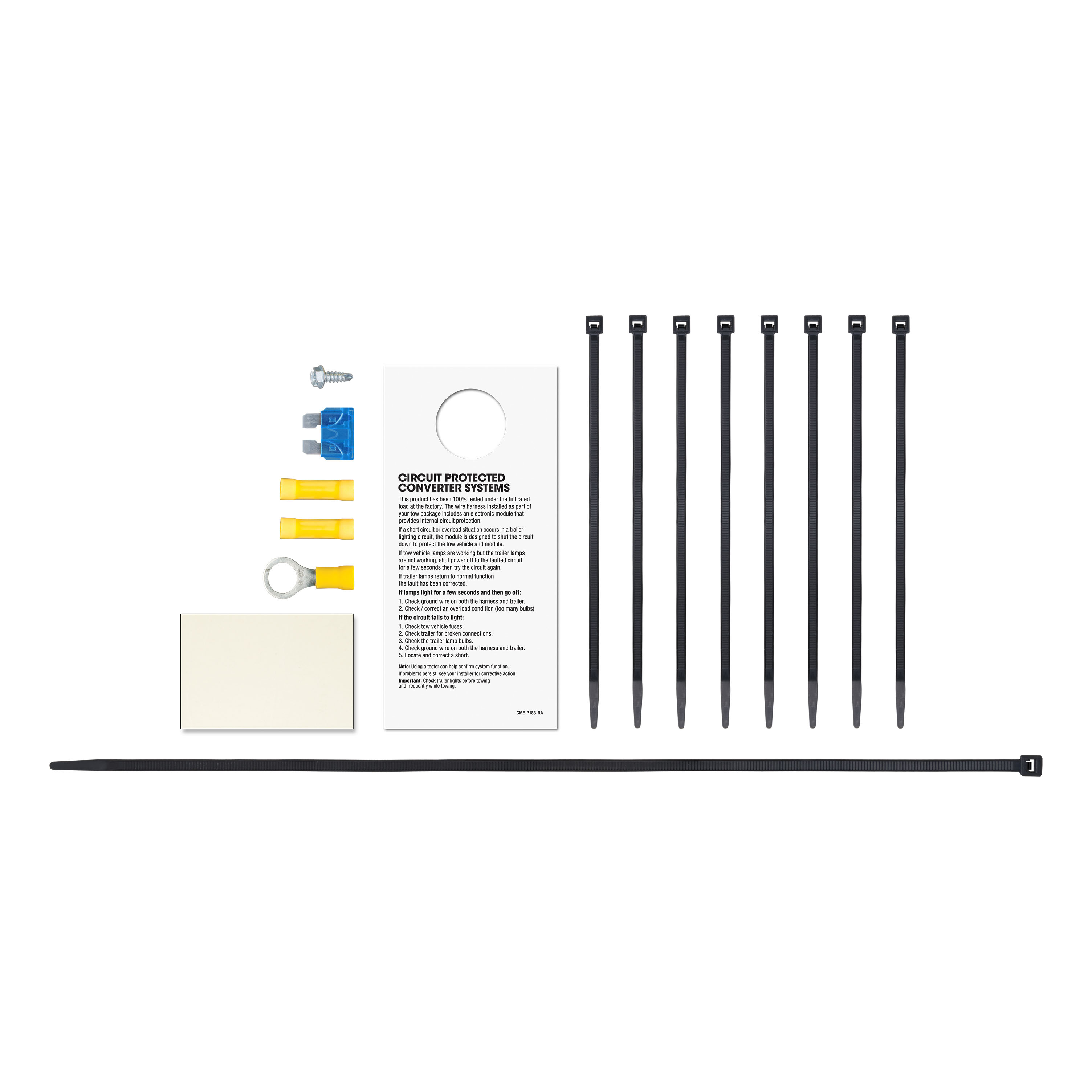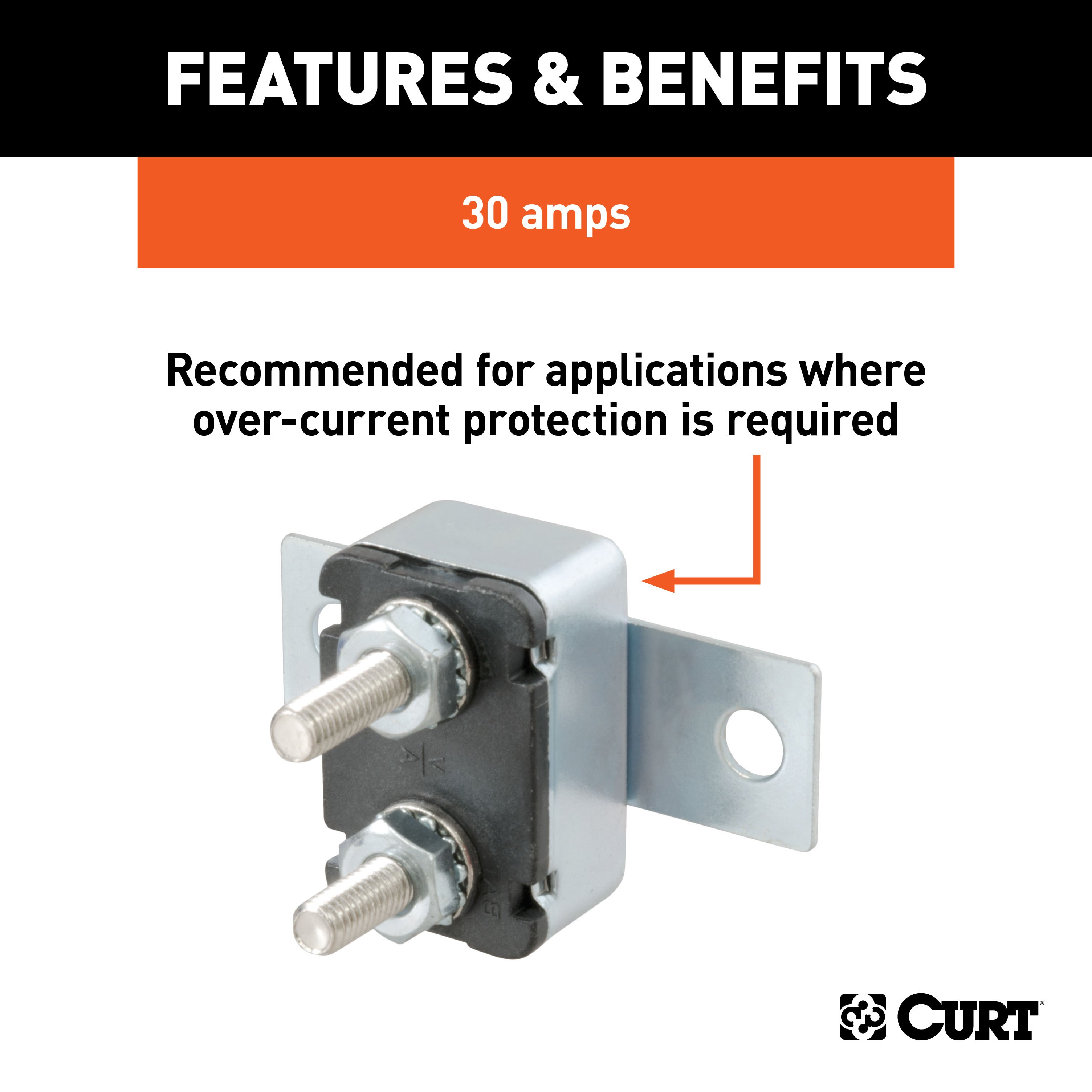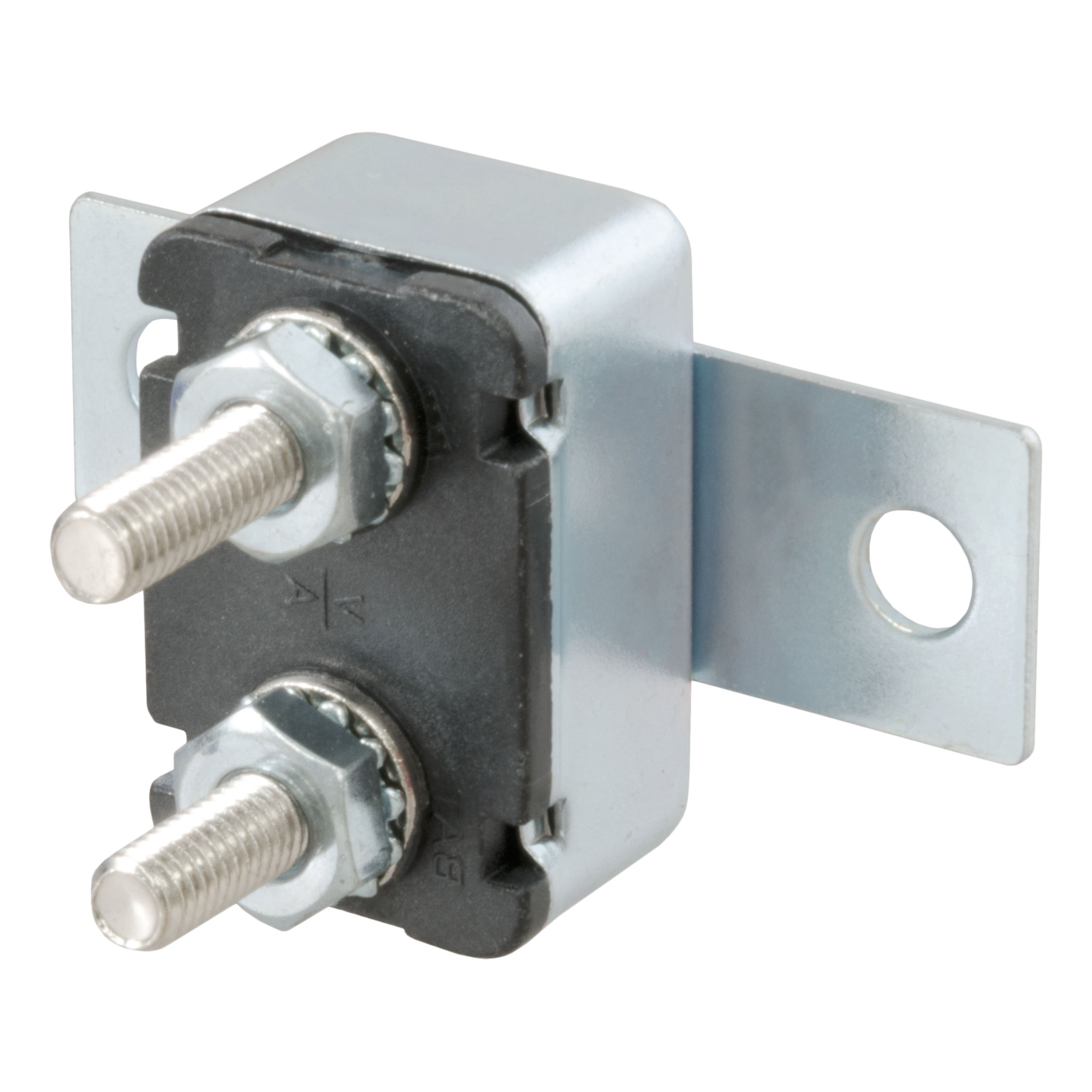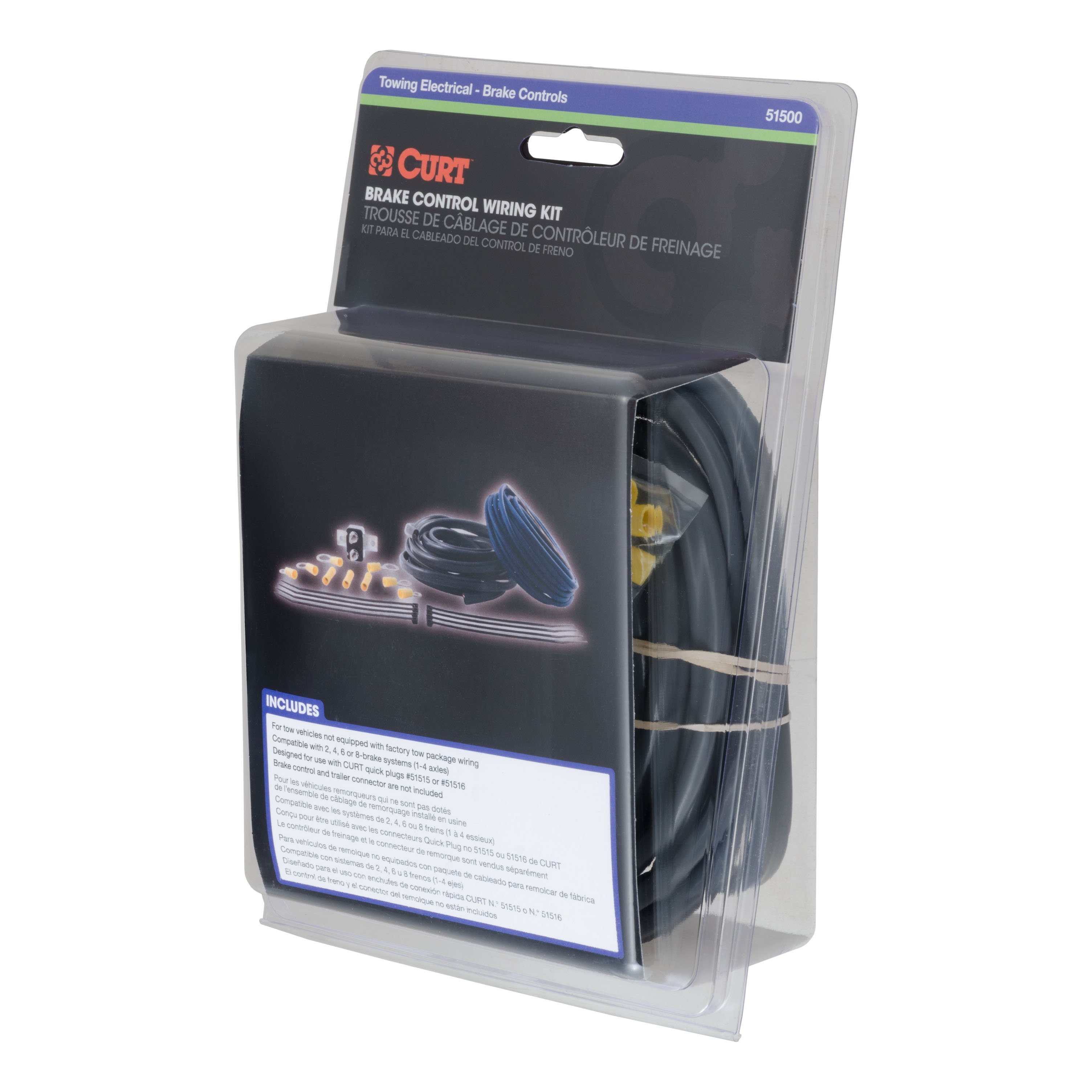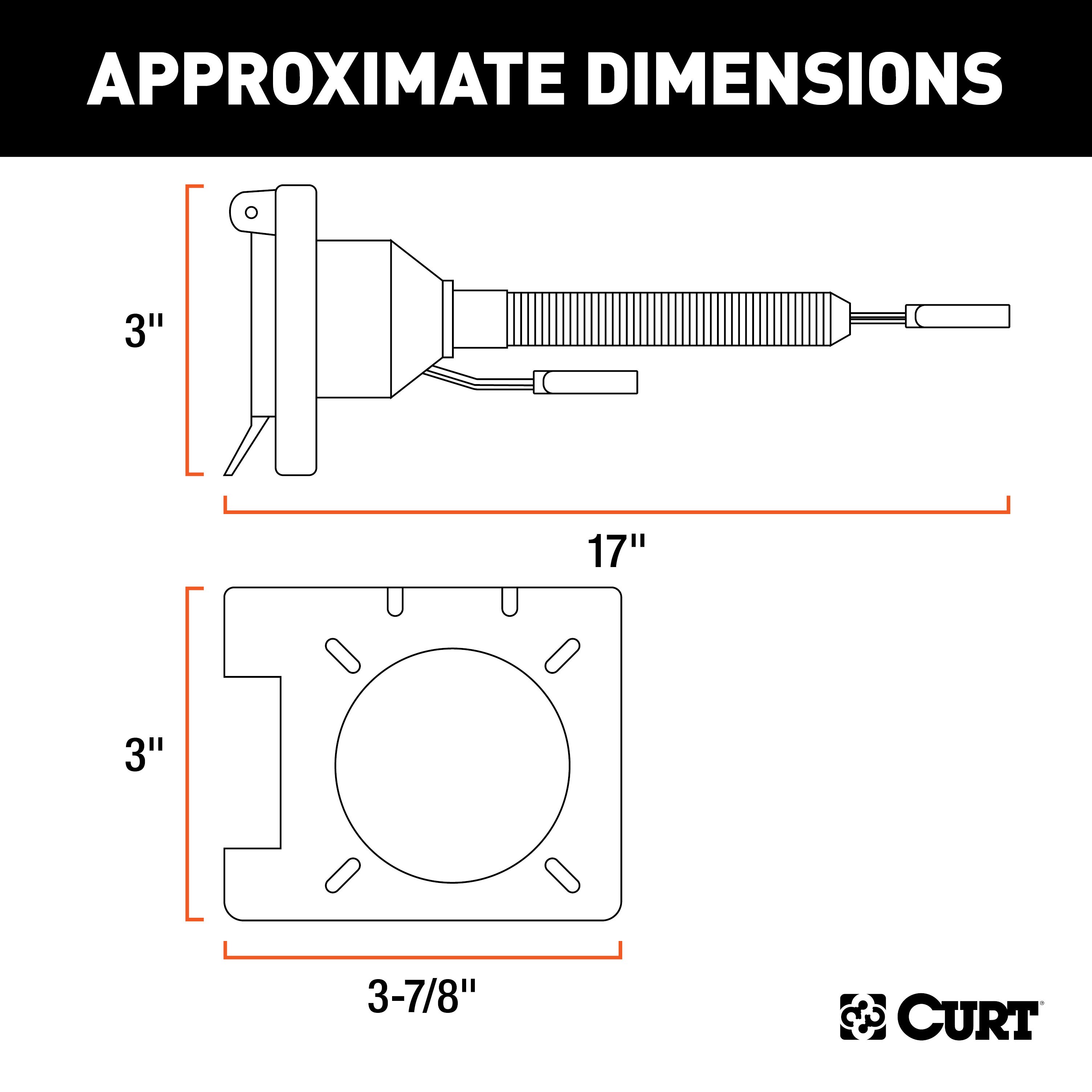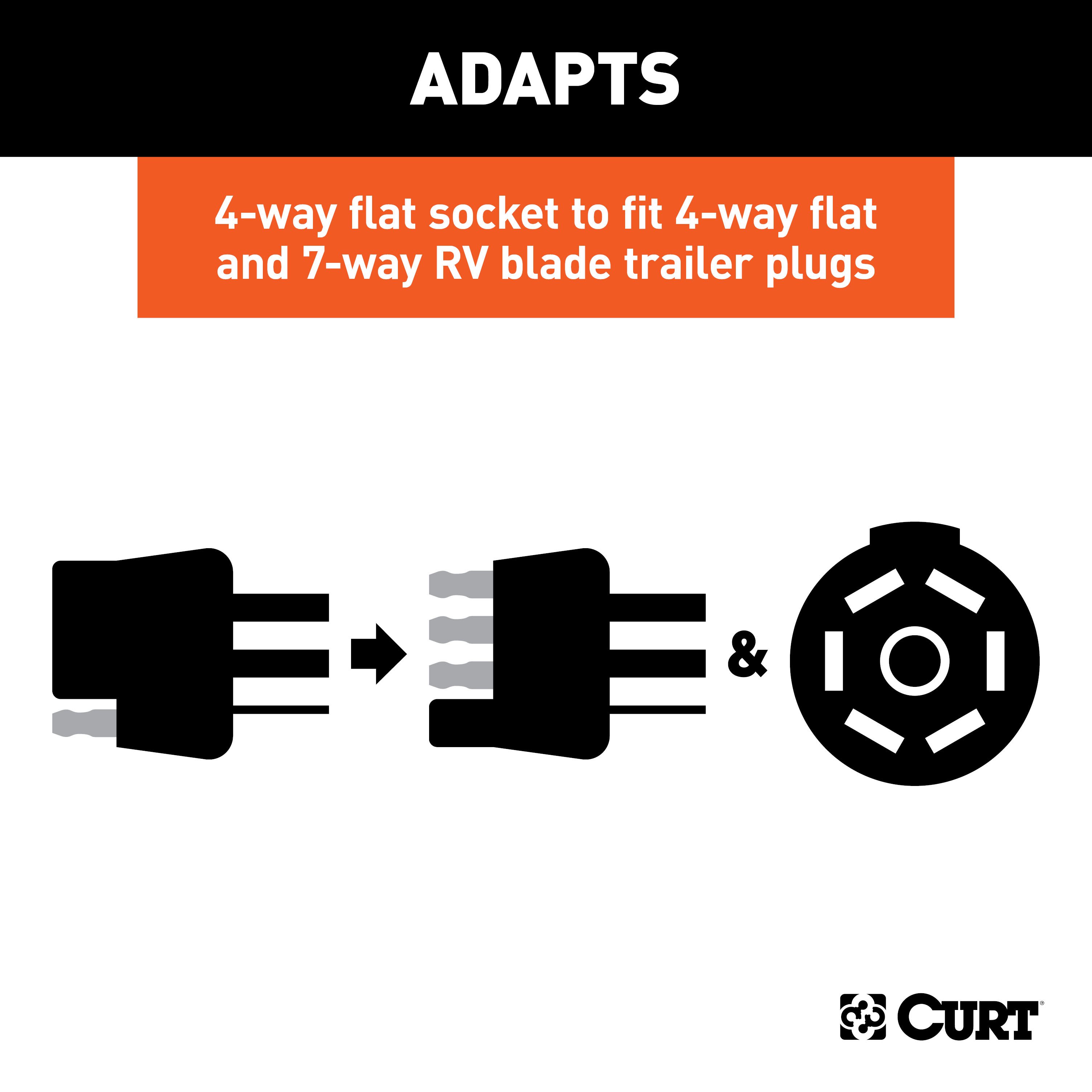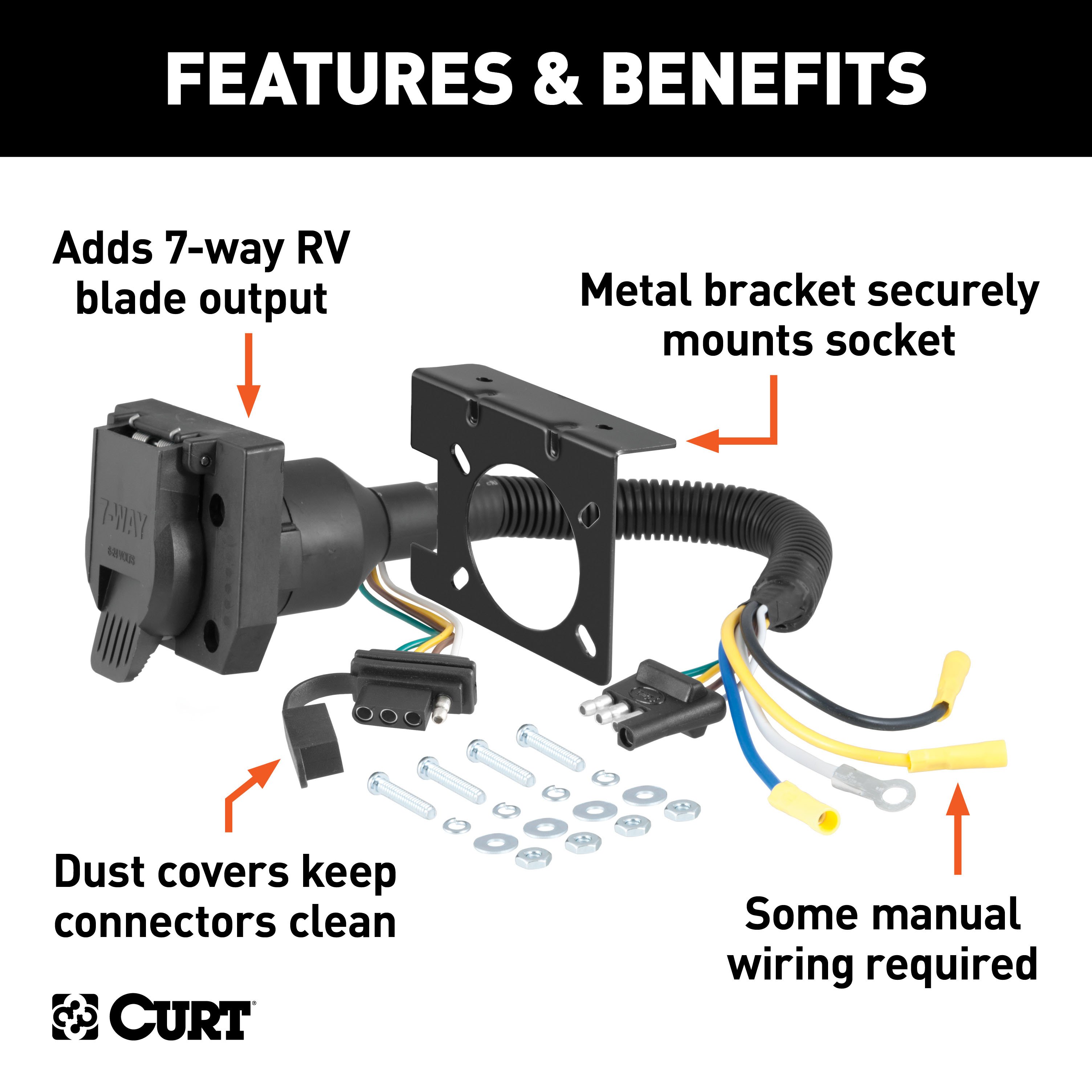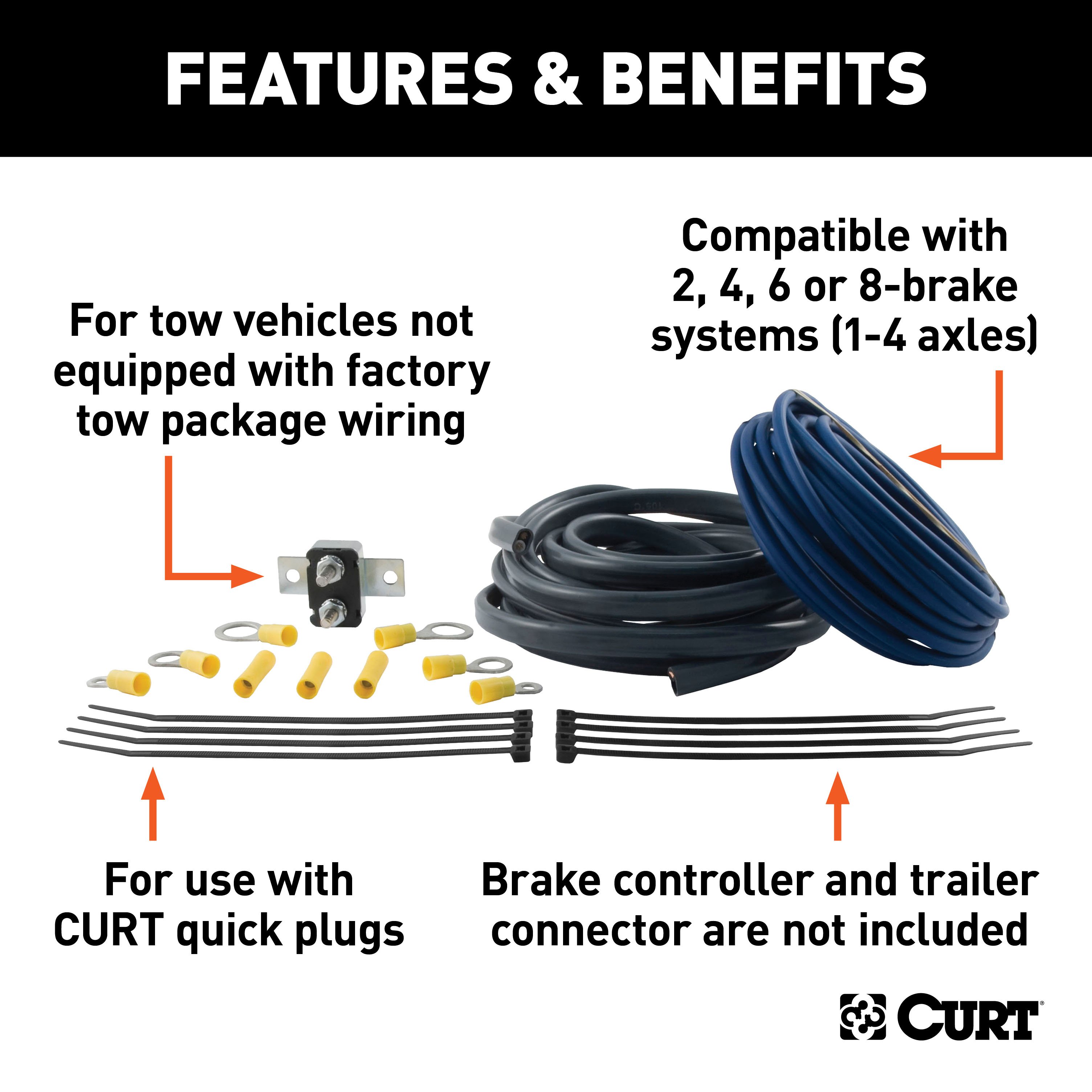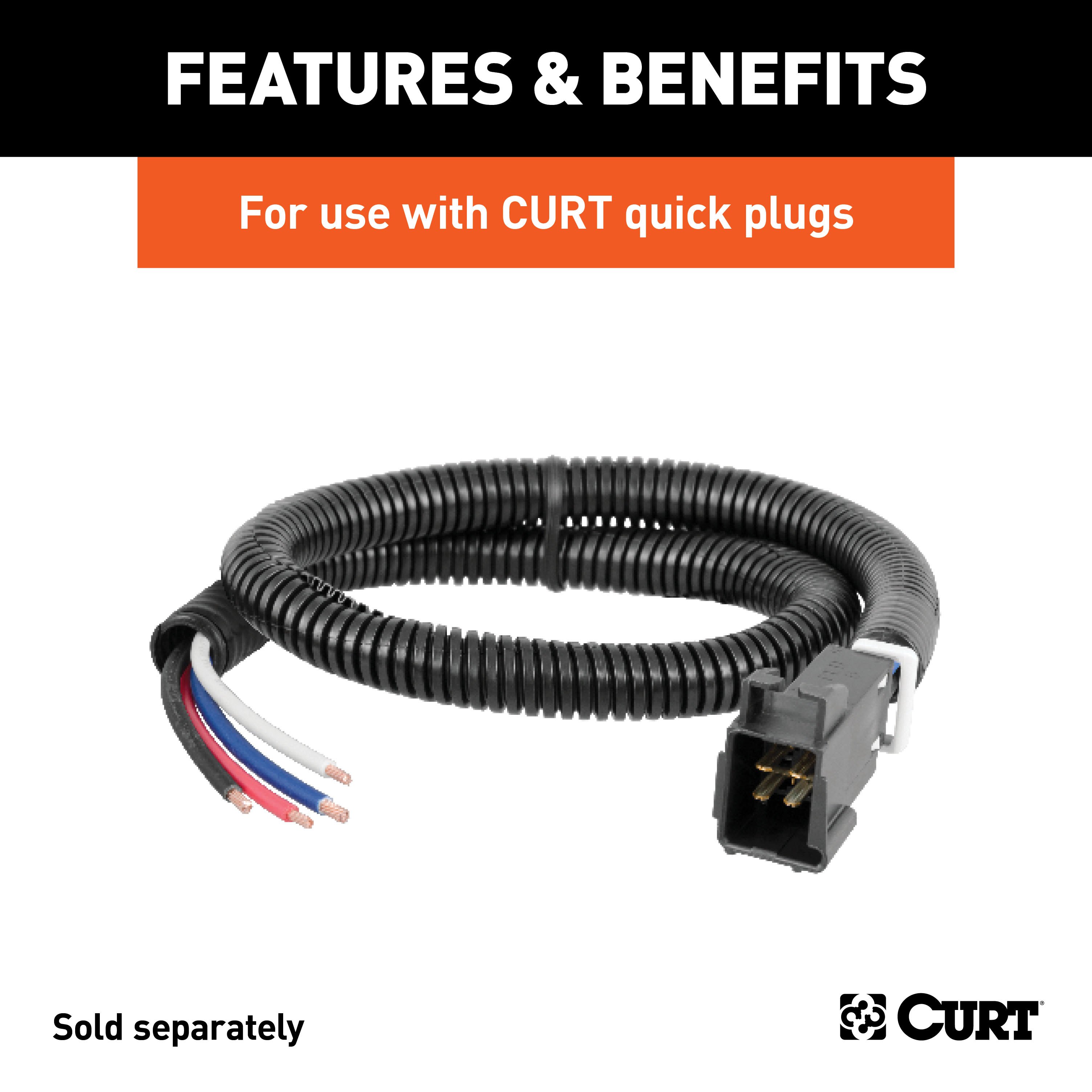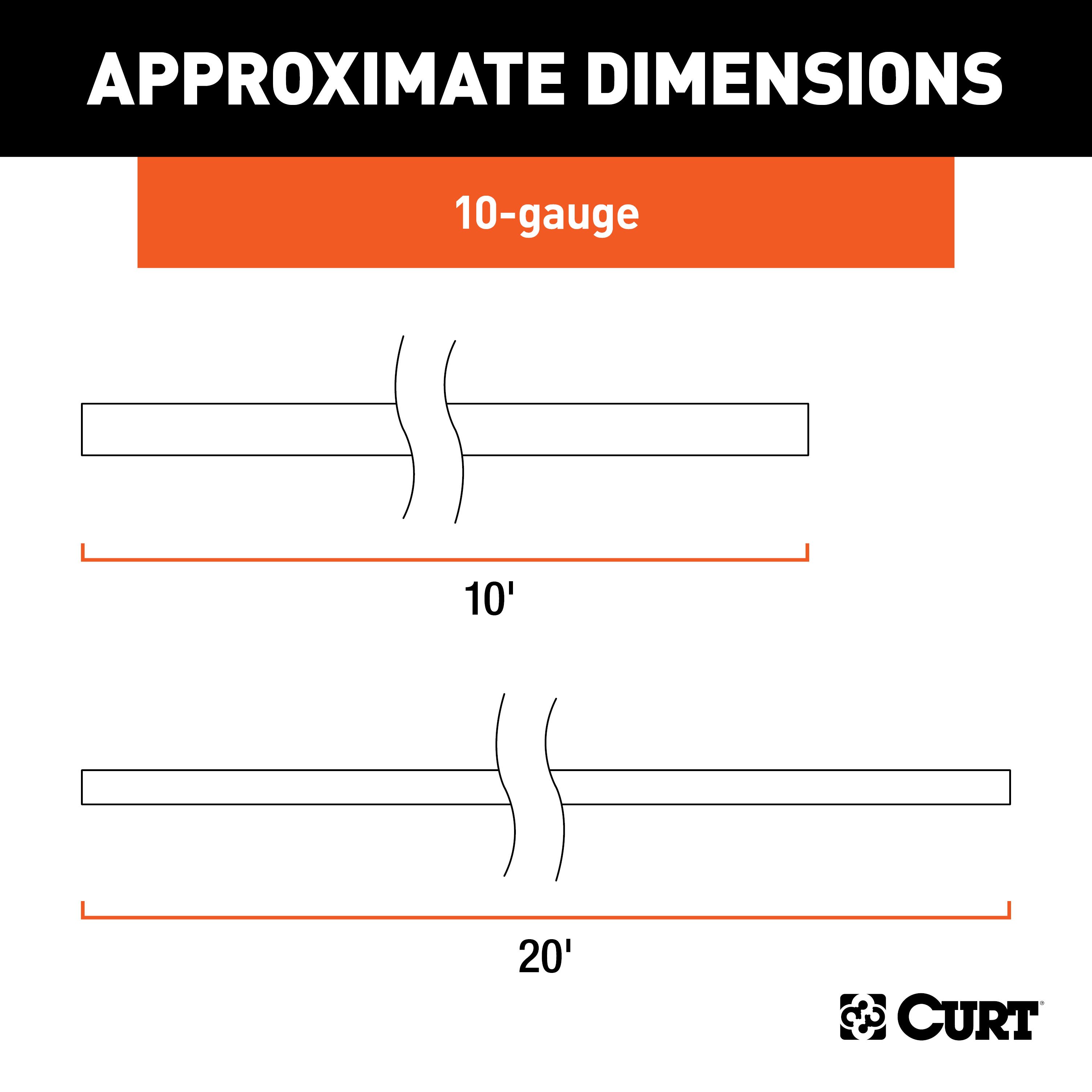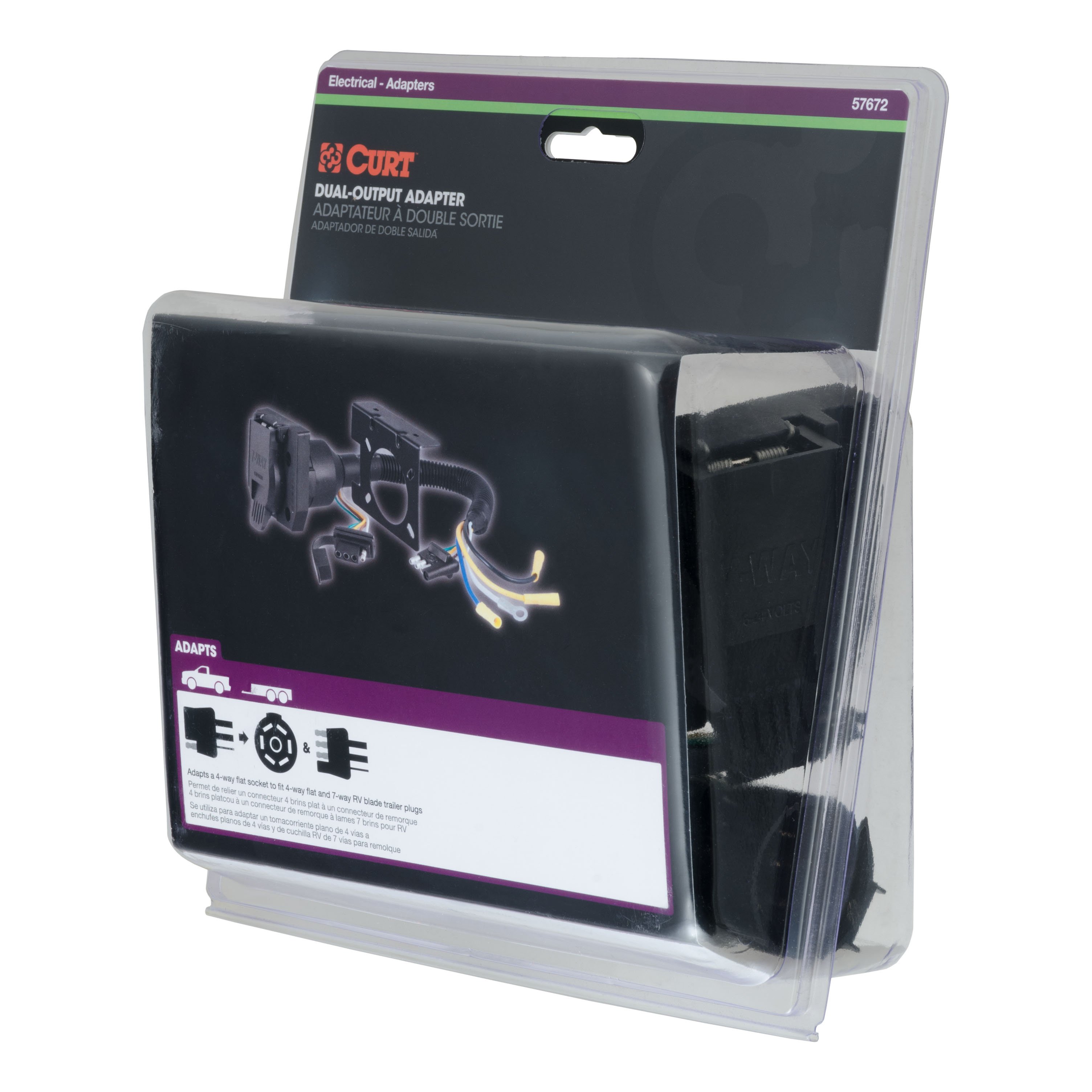Product Details
- Brand: Curt
- Model: 13201 51515 59236 57672 51500 58361 45042 51160-CH828
- Includes: Class 3 Trailer Tow Hitch, Multi-Function Taillight Converter Kit, Universal Trailer Brake Controller Harness with Pigtails, Dual-Output Electrical Adapter, Trailer Brake Controller Wiring Kit, 30-Amp Universal Circuit Breaker, Loaded Ball Mount with 2-5/16" Ball 2" Shank, Assure Proportional Trailer Brake Controller with Dynamic Screen
Compatibility Chart
Description
Get Expert Help
For 2011-2020 Dodge Journey Tow Package Camp n' Field Trailer Hitch + Brake Controller Curt Assure 51160 Proportional Up To 4 Axles + 7 Way Trailer Wiring Plug & 2-5/16" ball 4 inch drop Fits Models w/o LED Taillights Curt 13201 2 inch Tow Receiv Install Notes
Installation Instructions for Dodge Journey (Including Crossroad Trim)
Part Numbers:
- 13201
Tools Required:
- Ratchet
- Torque Wrench
- 3/4" Socket
- Small Pry Bar
- 6" Socket Extension
- Spray Lubricant
Hardware List:
- Carriage Bolt: 1/2-13 x 1-1/2", Grade 8, YZ (Qty: 6)
- Square Hole Spacer: 0.250 x 1.00 x 2.00" (Qty: 4)
- Square Hole Spacer: 0.250 x 1.50 x 3.00" (Qty: 2)
- Wedge Spacer: 1/2", YZ (Qty: 2)
- Hex Flange Nut: 1/2-13 UNC, Grade 8, YZ (Qty: 6)
- Fishwire: 1/2" (Qty: 2)
Step-by-Step Instructions:
-
Lower the Exhaust:
- Remove the three rubber isolators on each side to lower the exhaust.
- Support the exhaust system from underneath to avoid damage.
- Apply spray lubricant or soapy water to ease the removal of isolators.
-
Fishwire Carriage Bolts and Small Spacers:
- Fishwire the 1/2" carriage bolts and small square hole spacers through the space between the bumper beam and the end of the frame rail on both sides.
-
Fishwire Carriage Bolts and Large Spacers:
- Fishwire the remaining 1/2" carriage bolts and large square hole spacers through the bumper beam and into position.
-
Raise Hitch into Position:
- Raise the hitch into position. Insert the wedge spacers between the hitch and the frame as shown in the diagram.
- Secure the hitch using the 1/2" hex flange nuts.
- Note: Temporarily disconnect the driver-side electrical connector for better clearance if needed.
-
Torque Fasteners:
- Torque all 1/2" fasteners to 110 ft-lbs.
-
Reinstall Exhaust:
- Raise the exhaust back into position and reinstall the six rubber isolators removed in Step 1.
- Use spray lubricant or soapy water to ease reinstallation.
Safety Notes:
- No Drilling Required: The installation uses existing holes in the frame and bumper beam.
- Fishwiring Required: Carefully fishwire hardware into place to prevent losing bolts inside the frame rails.
Specifications:
- Gross Load Capacity (Weight Carrying Hitch):
- Trailer Weight: 4,000 lbs
- Tongue Weight: 400 lbs
- Gross Load Capacity (Weight Distribution Hitch):
- Trailer Weight: 4,000 lbs
- Tongue Weight: 400 lbs
- Hitch Weight: 28 lbs
Installation Time:
- Professional: 30 minutes
- Novice (DIY): 60 minutes
Manufacturer Notes:
- For installation questions, contact Technical Support at 1-877-287-8634.
- Product Warranty: Curt Manufacturing Inc. guarantees this product to be free from defects in material and workmanship.
Warning: Periodically check the hitch to ensure all fasteners are tight and components are structurally sound. Do not exceed the vehicle manufacturer's recommended towing capacity.
Installation Instructions for Dodge Journey (Including Crossroad Trim)
Part Numbers:
- 13201
Tools Required:
- Ratchet
- Torque Wrench
- 3/4" Socket
- Small Pry Bar
- 6" Socket Extension
- Spray Lubricant
Hardware List:
- Carriage Bolt: 1/2-13 x 1-1/2", Grade 8, YZ (Qty: 6)
- Square Hole Spacer: 0.250 x 1.00 x 2.00" (Qty: 4)
- Square Hole Spacer: 0.250 x 1.50 x 3.00" (Qty: 2)
- Wedge Spacer: 1/2", YZ (Qty: 2)
- Hex Flange Nut: 1/2-13 UNC, Grade 8, YZ (Qty: 6)
- Fishwire: 1/2" (Qty: 2)
Step-by-Step Instructions:
-
Lower the Exhaust:
- Remove the three rubber isolators on each side to lower the exhaust.
- Support the exhaust system from underneath to avoid damage.
- Apply spray lubricant or soapy water to ease the removal of isolators.
-
Fishwire Carriage Bolts and Small Spacers:
- Fishwire the 1/2" carriage bolts and small square hole spacers through the space between the bumper beam and the end of the frame rail on both sides.
-
Fishwire Carriage Bolts and Large Spacers:
- Fishwire the remaining 1/2" carriage bolts and large square hole spacers through the bumper beam and into position.
-
Raise Hitch into Position:
- Raise the hitch into position. Insert the wedge spacers between the hitch and the frame as shown in the diagram.
- Secure the hitch using the 1/2" hex flange nuts.
- Note: Temporarily disconnect the driver-side electrical connector for better clearance if needed.
-
Torque Fasteners:
- Torque all 1/2" fasteners to 110 ft-lbs.
-
Reinstall Exhaust:
- Raise the exhaust back into position and reinstall the six rubber isolators removed in Step 1.
- Use spray lubricant or soapy water to ease reinstallation.
Safety Notes:
- No Drilling Required: The installation uses existing holes in the frame and bumper beam.
- Fishwiring Required: Carefully fishwire hardware into place to prevent losing bolts inside the frame rails.
Specifications:
- Gross Load Capacity (Weight Carrying Hitch):
- Trailer Weight: 4,000 lbs
- Tongue Weight: 400 lbs
- Gross Load Capacity (Weight Distribution Hitch):
- Trailer Weight: 4,000 lbs
- Tongue Weight: 400 lbs
- Hitch Weight: 28 lbs
Installation Time:
- Professional: 30 minutes
- Novice (DIY): 60 minutes
Warranty Information:
Attention: This is a summary of the installation procedure. For complete installation instructions, including diagrams and detailed information from the manufacturer, please download the full installation PDF.
- Warranty covers defects in material and workmanship at the time of purchase. For complete warranty instructions, please download the full installation PDF.
Technical Support:
For technical support and assistance, our team of experts is available to help. You can reach our tech support by visiting www.trailerjacks.com or calling 877-869-6690.
Warning: Periodically check the hitch to ensure all fasteners are tight and components are structurally sound. Do not exceed the vehicle manufacturer's recommended towing capacity.
Installation Instructions for Wiring Harness with Powered Converter
Part Numbers:
- 59236
Wiring Access Location:
Refer to the wiring location guides based on vehicle type provided in the manual:
SUVs and Vans:
- S1: Behind driver-side taillight housing
- S2: Behind passenger-side taillight housing
- S3: Behind driver-side rear access panel
- S4: Behind passenger-side rear access panel
- S5: Behind driver-side rear bumper
- S6: Behind the center of the rear bumper
- S7: Behind passenger-side rear bumper
- S8: Under rear floor panel
Passenger Cars:
- P1: Behind driver-side taillight housing, outside of the trunk
- P2: Behind passenger-side taillight housing, outside of the trunk
- P3: Behind driver-side taillight housing, inside the trunk
- P4: Behind passenger-side taillight housing, inside the trunk
- P5: Behind driver-side rear bumper
- P6: Behind the center of the rear bumper
- P7: Behind passenger-side rear bumper
Trucks:
- T1: Behind driver-side taillight housing
- T2: Behind passenger-side taillight housing
- T3: Behind driver-side rear bumper
- T4: Behind the center of the rear bumper fascia
- T5: Behind passenger-side rear bumper
Determining Vehicle Wiring Types:
To identify the vehicle wiring type, follow these steps:
- Ensure all lights on the vehicle are off.
- Probe the taillight connectors while they remain connected to the vehicle.
- Use the following wiring descriptions to determine the vehicle type:
Wiring Types:
-
Two-Wire System:
- Combined stop and turn signal with an independent tail signal.
- Indicator: Flashing signal on one side for turn signals; both sides activate for brakes.
-
Three-Wire System:
- Independent stop, turn, and tail signals.
- Indicator: Separate wires for turn signals and brake lights.
-
PWM-ST System:
- Combined stop and tail signal with an independent turn signal.
- Indicator: Stop and tail signals use the same wire; separate turn signal wires.
-
PWM-STT System:
- Combined stop, turn, and tail signal.
- Indicator: A single wire serves stop, turn, and tail functions.
Tools Required:
- Test light
- Utility knife
- Electrical tape
- Wire crimper
- Paper
- Wire stripper
- Pen
Step-by-Step Instructions:
-
Locate the Vehicle Battery
- Disconnect the negative battery terminal securely.
-
Identify Vehicle Taillight Wiring
- Use the wiring location guide and instructions for determining the wiring type.
-
Attach the Input Wires
- Match wires using snap locks:
- Green Wire: Splice to the right stop/turn wire.
- Red Wire: Ground with the white wire.
- Yellow Wire: Splice to the left stop/turn wire.
- Brown Wire: Splice to the tail wire.
- Match wires using snap locks:
-
Mount the Converter
- Secure the black converter box near the taillight using the provided double-sided tape.
-
Ground the White Wire
- Use the ring terminal and provided screw to ground the wire at a clean, rust-free location.
-
Route the Power Wire
- Route the black wire to the positive battery terminal, avoiding pinch points or hot components.
-
Install the Fuse
- Add the 15-amp fuse after completing all other steps.
-
Test the System
- Verify turn signals, brake lights, and tail lights using a test light or trailer.
-
Reinstall Components
- Reinstall all removed parts and reconnect the negative battery terminal.
Hardware List:
- Snap locks
- 15-amp fuse and holder
- Ring terminal
- Cable ties
- Double-sided tape
Safety Notes:
- Do not exceed product or tow vehicle lamp load ratings.
- Inspect all wiring periodically for damage or loose connections.
- Avoid drilling without confirming there are no hidden items behind the surface.
Specifications:
- Signal Circuits: 5.0-amps per side
- Tail/Running Circuits: 7.5-amps total
- Compliance: SAE J684
Installation Instructions for Wiring Harness with Powered Converter
Part Numbers:
- 59236
Wiring Access Location:
Refer to the wiring location guides based on vehicle type provided in the manual:
SUVs and Vans:
- S1: Behind driver-side taillight housing
- S2: Behind passenger-side taillight housing
- S3: Behind driver-side rear access panel
- S4: Behind passenger-side rear access panel
- S5: Behind driver-side rear bumper
- S6: Behind the center of the rear bumper
- S7: Behind passenger-side rear bumper
- S8: Under rear floor panel
Passenger Cars:
- P1: Behind driver-side taillight housing, outside of the trunk
- P2: Behind passenger-side taillight housing, outside of the trunk
- P3: Behind driver-side taillight housing, inside the trunk
- P4: Behind passenger-side taillight housing, inside the trunk
- P5: Behind driver-side rear bumper
- P6: Behind the center of the rear bumper
- P7: Behind passenger-side rear bumper
Trucks:
- T1: Behind driver-side taillight housing
- T2: Behind passenger-side taillight housing
- T3: Behind driver-side rear bumper
- T4: Behind the center of the rear bumper fascia
- T5: Behind passenger-side rear bumper
Determining Vehicle Wiring Types:
To identify the vehicle wiring type, follow these steps:
- Ensure all lights on the vehicle are off.
- Probe the taillight connectors while they remain connected to the vehicle.
- Use the following wiring descriptions to determine the vehicle type:
Wiring Types:
-
Two-Wire System:
- Combined stop and turn signal with an independent tail signal.
- Indicator: Flashing signal on one side for turn signals; both sides activate for brakes.
-
Three-Wire System:
- Independent stop, turn, and tail signals.
- Indicator: Separate wires for turn signals and brake lights.
-
PWM-ST System:
- Combined stop and tail signal with an independent turn signal.
- Indicator: Stop and tail signals use the same wire; separate turn signal wires.
-
PWM-STT System:
- Combined stop, turn, and tail signal.
- Indicator: A single wire serves stop, turn, and tail functions.
Tools Required:
- Test light
- Utility knife
- Electrical tape
- Wire crimper
- Paper
- Wire stripper
- Pen
Step-by-Step Instructions:
-
Locate the Vehicle Battery
- Disconnect the negative battery terminal securely.
-
Identify Vehicle Taillight Wiring
- Use the wiring location guide and instructions for determining the wiring type.
-
Attach the Input Wires
- Match wires using snap locks:
- Green Wire: Splice to the right stop/turn wire.
- Red Wire: Ground with the white wire.
- Yellow Wire: Splice to the left stop/turn wire.
- Brown Wire: Splice to the tail wire.
- Match wires using snap locks:
-
Mount the Converter
- Secure the black converter box near the taillight using the provided double-sided tape.
-
Ground the White Wire
- Use the ring terminal and provided screw to ground the wire at a clean, rust-free location.
-
Route the Power Wire
- Route the black wire to the positive battery terminal, avoiding pinch points or hot components.
-
Install the Fuse
- Add the 15-amp fuse after completing all other steps.
-
Test the System
- Verify turn signals, brake lights, and tail lights using a test light or trailer.
-
Reinstall Components
- Reinstall all removed parts and reconnect the negative battery terminal.
Hardware List:
- Snap locks
- 15-amp fuse and holder
- Ring terminal
- Cable ties
- Double-sided tape
Safety Notes:
- Do not exceed product or tow vehicle lamp load ratings.
- Inspect all wiring periodically for damage or loose connections.
- Avoid drilling without confirming there are no hidden items behind the surface.
Specifications:
- Signal Circuits: 5.0-amps per side
- Tail/Running Circuits: 7.5-amps total
- Compliance: SAE J684
Additional Information:
- Attention: This is a summary of the installation procedure. For complete installation instructions, including diagrams and detailed information from the manufacturer, please download the full installation PDF.
Technical Support:
- For technical support and assistance, our team of experts is available to help. You can reach our tech support by visiting www.trailerjacks.com or calling 877-869-6690.
Warranty:
- Warranty Duration: [Insert warranty period]
- Coverage Details: [Insert coverage details]
- For complete warranty information, please download the full installation PDF.
Note: Ensure all connections are secure and test the wiring with a properly wired trailer or test light to confirm functionality.
Installation Instructions for 4-Way to 7-Way Adapter and Brake Control Wiring
Tools Required:
- Phillips Head Screwdriver
- Drill with 3/32" Drill Bit
- 10mm Socket & Ratchet or Wrench
- Wire Crimpers
- Wire Cutters
- Test Light or Multimeter
- Cable Ties
Part 1: Install the 4-Way to 7-Way Adapter
Step-by-Step Instructions:
-
Mount the Adapter:
- Choose a suitable mounting point on the vehicle, typically near the hitch.
- Use the provided bracket and screws to secure the adapter.
-
Connect the 4-Flat Plug:
- Plug the 4-flat connector on the adapter into the existing 4-flat plug on the vehicle.
- This connection enables tail lights, left turn, and right turn signals.
-
Ground the Adapter:
- Locate a clean, solid grounding point near the adapter.
- Drill a 3/32" hole if necessary and secure the white ground wire from the adapter using the provided screw and eyelet.
-
Leave Additional Wires Disconnected:
- The following wires will remain disconnected until Part 2:
- Black Wire: Power from the battery.
- Blue Wire: Brake control output.
- Yellow Wire: Reverse light (optional; leave disconnected unless needed).
- The following wires will remain disconnected until Part 2:
-
Test Initial Connection:
- Use a test light or trailer to verify functionality of the 4-way connections (tail lights, turn signals).
Part 2: Install Brake Control Wiring
Step-by-Step Instructions:
-
Mount Circuit Breakers:
- Install two 30A circuit breakers on the firewall or another suitable location near the battery.
- Use self-tapping screws to mount them securely.
-
Route Power Wires:
- Connect the black 12-gauge wire from the 7-way adapter to the auxiliary side of one circuit breaker (this powers the 7-way socket).
- Run a heavy-gauge wire from the battery's positive terminal to the battery side of this circuit breaker, using a ring terminal.
- Run another heavy-gauge wire from the battery's positive terminal to the auxiliary side of the second circuit breaker (for the brake controller).
-
Install the Brake Controller:
- Mount the brake controller under the dash on a firm surface.
- Use the following connections:
- Red Wire: Connect to the cold side of the brake switch (active only when the brake pedal is pressed).
- Blue Wire: Connect to the blue wire on the 7-way adapter for trailer brakes.
- White Wire: Connect to a solid ground point on the vehicle body.
- Black Wire: Connect to the auxiliary side of the second 30A circuit breaker (provides power to the brake controller).
-
Optional: Connect Reverse Light Circuit:
- If the trailer has a reverse light circuit, connect the yellow wire from the 7-way adapter to the vehicle’s reverse light circuit.
-
Reconnect the Battery:
- Reattach the negative battery cable and ensure all connections are secure.
- Insert the fuses into both circuit breakers.
-
Secure All Wires:
- Use cable ties to secure all loose wires and prevent damage or rattling.
-
Test the System:
- Verify functionality of all circuits (running lights, turn signals, brake lights, and brake controller output).
- If applicable, test the reverse light circuit.
Notes:
- Most installations will only require connecting the black and blue wires from the 7-way adapter.
- Leave the yellow wire disconnected unless the trailer has a reverse light or surge brake lockout circuit.
- Always adhere to safety guidelines and verify all connections before use.
Warning: Incorrect wiring can cause damage to the vehicle or trailer. Test all connections carefully before use.
Installation Instructions for 4-Way to 7-Way Adapter and Brake Control Wiring
Tools Required:
- Phillips Head Screwdriver
- Drill with 3/32" Drill Bit
- 10mm Socket & Ratchet or Wrench
- Wire Crimpers
- Wire Cutters
- Test Light or Multimeter
- Cable Ties
Part 1: Install the 4-Way to 7-Way Adapter
Step-by-Step Instructions:
-
Mount the Adapter:
- Choose a suitable mounting point on the vehicle, typically near the hitch.
- Use the provided bracket and screws to secure the adapter.
-
Connect the 4-Flat Plug:
- Plug the 4-flat connector on the adapter into the existing 4-flat plug on the vehicle.
- This connection enables tail lights, left turn, and right turn signals.
-
Ground the Adapter:
- Locate a clean, solid grounding point near the adapter.
- Drill a 3/32" hole if necessary and secure the white ground wire from the adapter using the provided screw and eyelet.
-
Leave Additional Wires Disconnected:
- The following wires will remain disconnected until Part 2:
- Black Wire: Power from the battery.
- Blue Wire: Brake control output.
- Yellow Wire: Reverse light (optional; leave disconnected unless needed).
- The following wires will remain disconnected until Part 2:
-
Test Initial Connection:
- Use a test light or trailer to verify functionality of the 4-way connections (tail lights, turn signals).
Part 2: Install Brake Control Wiring
Step-by-Step Instructions:
-
Mount Circuit Breakers:
- Install two 30A circuit breakers on the firewall or another suitable location near the battery.
- Use self-tapping screws to mount them securely.
-
Route Power Wires:
- Connect the black 12-gauge wire from the 7-way adapter to the auxiliary side of one circuit breaker (this powers the 7-way socket).
- Run a heavy-gauge wire from the battery's positive terminal to the battery side of this circuit breaker, using a ring terminal.
- Run another heavy-gauge wire from the battery's positive terminal to the auxiliary side of the second circuit breaker (for the brake controller).
-
Install the Brake Controller:
- Mount the brake controller under the dash on a firm surface.
- Use the following connections:
- Red Wire: Connect to the cold side of the brake switch (active only when the brake pedal is pressed).
- Blue Wire: Connect to the blue wire on the 7-way adapter for trailer brakes.
- White Wire: Connect to a solid ground point on the vehicle body.
- Black Wire: Connect to the auxiliary side of the second 30A circuit breaker (provides power to the brake controller).
-
Optional: Connect Reverse Light Circuit:
- If the trailer has a reverse light circuit, connect the yellow wire from the 7-way adapter to the vehicle’s reverse light circuit.
-
Reconnect the Battery:
- Reattach the negative battery cable and ensure all connections are secure.
- Insert the fuses into both circuit breakers.
-
Secure All Wires:
- Use cable ties to secure all loose wires and prevent damage or rattling.
-
Test the System:
- Verify functionality of all circuits (running lights, turn signals, brake lights, and brake controller output).
- If applicable, test the reverse light circuit.
Notes:
- Most installations will only require connecting the black and blue wires from the 7-way adapter.
- Leave the yellow wire disconnected unless the trailer has a reverse light or surge brake lockout circuit.
- Always adhere to safety guidelines and verify all connections before use.
Warning: Incorrect wiring can cause damage to the vehicle or trailer. Test all connections carefully before use.
Attention:
This is a summary of the installation procedure. For complete installation instructions, including diagrams and detailed information from the manufacturer, please download the full installation PDF.
Warranty Information:
For complete warranty instructions, please download the full installation PDF.
Technical Support:
For technical support and assistance, our team of experts is available to help. You can reach our tech support by visiting www.trailerjacks.com or calling 877-869-6690.
Installation Instructions for Brake Control Plugin Wiring Harness (Part 51515)
Tools Required:
- Wire Stripper & Cutter
- Pliers
Overview:
This brake control plugin wiring harness is designed for quick and secure connections to your brake controller. It simplifies installation by matching functions and connecting to the corresponding wires in your vehicle.
Step-by-Step Instructions:
-
Disconnect the Battery:
- Before beginning, disconnect the battery terminals to prevent electrical shorts or damage.
-
Connect the Wires:
- Refer to the following chart to match the harness wires to their functions:
- Black Wire: Battery Positive (+)
- Red Wire: Stoplight Signal (active when the brake pedal is pressed)
- White Wire: Ground (-)
- Blue Wire: Output to Trailer Brakes
- Use the appropriate connectors to secure each wire, ensuring a solid connection.
- Refer to the following chart to match the harness wires to their functions:
-
Secure the Wiring Harness:
- Mount the wiring harness under the dashboard or another safe location, keeping it away from moving parts or sharp edges.
-
Plug in the Brake Controller:
- Insert the wiring harness connector into the brake controller, ensuring it clicks securely into place.
-
Reconnect the Battery:
- Reattach the battery terminals, ensuring they are clean and tightly connected.
-
Test the System:
- Use a test light, circuit tester, or trailer to verify all functions:
- The brake controller powers on.
- The manual override activates the trailer brakes.
- Stoplight signals and trailer brakes function properly when the brake pedal is pressed.
- Use a test light, circuit tester, or trailer to verify all functions:
Notes:
- Always connect wires based on function, not color, to ensure proper operation.
- Consult your vehicle manual for fuse locations related to the brake control system.
- Verify all connections are secure and tested before use.
Warning:
- All connections must be complete for the system to function properly.
- Overloading circuits can cause damage or fire. Do not exceed the lower of the towing manufacturer’s ratings or:
- Max. Right Turn, Left Turn, Stop, & Tail Light Circuits: 7.5 amps
- Max. (+) Battery, Reverse, and Electric Brake Circuits: 30 amps
- Refer to your vehicle’s owner’s manual for additional instructions. Additional fusing may be required.
For safe towing and optimal performance, ensure all connections are properly secured and tested.
Installation Instructions for Brake Control Plugin Wiring Harness (Part 51515)
Tools Required:
- Wire Stripper & Cutter
- Pliers
Overview:
This brake control plugin wiring harness is designed for quick and secure connections to your brake controller. It simplifies installation by matching functions and connecting to the corresponding wires in your vehicle.
Step-by-Step Instructions:
-
Disconnect the Battery:
- Before beginning, disconnect the battery terminals to prevent electrical shorts or damage.
-
Connect the Wires:
- Refer to the following chart to match the harness wires to their functions:
- Black Wire: Battery Positive (+)
- Red Wire: Stoplight Signal (active when the brake pedal is pressed)
- White Wire: Ground (-)
- Blue Wire: Output to Trailer Brakes
- Use the appropriate connectors to secure each wire, ensuring a solid connection.
- Refer to the following chart to match the harness wires to their functions:
-
Secure the Wiring Harness:
- Mount the wiring harness under the dashboard or another safe location, keeping it away from moving parts or sharp edges.
-
Plug in the Brake Controller:
- Insert the wiring harness connector into the brake controller, ensuring it clicks securely into place.
-
Reconnect the Battery:
- Reattach the battery terminals, ensuring they are clean and tightly connected.
-
Test the System:
- Use a test light, circuit tester, or trailer to verify all functions:
- The brake controller powers on.
- The manual override activates the trailer brakes.
- Stoplight signals and trailer brakes function properly when the brake pedal is pressed.
- Use a test light, circuit tester, or trailer to verify all functions:
Notes:
- Always connect wires based on function, not color, to ensure proper operation.
- Consult your vehicle manual for fuse locations related to the brake control system.
- Verify all connections are secure and tested before use.
Warning:
- All connections must be complete for the system to function properly.
- Overloading circuits can cause damage or fire. Do not exceed the lower of the towing manufacturer’s ratings or:
- Max. Right Turn, Left Turn, Stop, & Tail Light Circuits: 7.5 amps
- Max. (+) Battery, Reverse, and Electric Brake Circuits: 30 amps
- Refer to your vehicle’s owner’s manual for additional instructions. Additional fusing may be required.
For safe towing and optimal performance, ensure all connections are properly secured and tested.
For complete installation instructions, including diagrams and detailed information from the manufacturer, please download the full installation PDF.
For technical support and assistance, our team of experts is available to help. You can reach our tech support by visiting www.trailerjacks.com or calling 877-869-6690.
Installation Instructions for Brake Controller
Product Information:
- Application: For trailers with 2 to 8 brakes
- System: 12-volt negative ground systems
Package Contents:
- (1) Brake Controller Module with Quick Plug
- (1) Mounting Bracket
- (2) Keyed Spacers
- (4) Mounting Bracket Screws
- (1) Quick Reference Card
- (2) Keyed Washers
Tools Required:
- Drill with 1/8" drill bit
- Wire Crimpers
- Wire Cutters
- Phillips Head Screwdriver
Key Features:
- Display for output and sensitivity settings
- Manual trailer braking control
- Switchable manual control options (100% or output setting)
- Brake light activation switch
- Reverse voltage and overload protection
- Compatible with electric and hydraulic trailer brake systems
Warnings and Important Notes:
- The brake controller’s positive and ground wires must connect directly to the vehicle’s battery with 10-gauge stranded wire.
- Avoid mounting near a CB radio or other RF transmitters.
- Disconnect the trailer plug when testing a breakaway switch.
Step-by-Step Installation Instructions:
1. Select the Mounting Location:
- The mounting location should be:
- Within the driver’s reach
- On a solid surface
- Free of obstructions behind the mounting surface
2. Install the Mounting Bracket:
- Position the bracket and mark the mounting holes.
- Drill holes using a 1/8” drill bit.
- Secure the bracket with the provided self-tapping screws (do not overtighten).
3. Attach the Brake Controller:
- Place the keyed spacer and washer on each side of the mounting bracket.
- Slide the brake controller into the bracket and secure it with screws.
4. Wiring the Brake Controller:
- Black Wire (Power Input): Connect to the positive (+) battery terminal through a 30-amp auto-reset circuit breaker.
- White Wire (Ground): Connect directly to the negative (-) battery terminal.
- Red Wire (Stoplight Input): Connect to the stoplight wire that is “hot” only when the brake pedal is pressed.
- Use a test probe to verify the correct wire.
- Blue Wire (Brake Output): Connect to the trailer’s brake control wire through the 7-way connector.
Switch Settings (Manual Control Configuration):
-
Brake Light Activation Switch:
- ON: Activates brake lights when the manual control is used (default).
- OFF: Brake lights remain inactive during manual braking.
-
Manual Brake Output Switch:
- ON: Limits manual braking to the gain (output) setting.
- OFF: Allows 100% braking power regardless of the output setting.
Setup and Calibration:
-
Connect the Trailer:
- Plug the trailer connector into the vehicle’s 7-way outlet.
- The controller will calibrate automatically, displaying "Calibration" followed by "Connected."
-
Set Initial Output and Sensitivity:
- Set the output to 2.0 and sensitivity (load) to 1.0 using the (+) and (-) buttons.
-
Test Drive and Adjust:
- Drive on a level surface at 25 mph.
- Press the brake pedal:
- Increase Output: If trailer braking feels insufficient.
- Decrease Output: If trailer brakes lock up.
- Adjust sensitivity for smoother stops using the (+) and (-) buttons.
Display Indicators:
| Indicator | Description |
|---|---|
| Connected | Trailer connected, standby mode |
| Not Connected | No trailer detected |
| Low Volt | Tow vehicle system voltage is low |
| Overload | Trailer brake system fault detected |
| Short | Stoplight wire shorted to ground |
| Error | Accelerometer error |
| Disconnect | Trailer disconnected |
Troubleshooting Guide:
- Display is Blank: Check power and ground connections.
- Display Shows "Low Volt": Verify vehicle’s battery and charging system.
- "Overload" Error: Inspect the blue wire and trailer brake circuit for shorts.
- No Trailer Brakes: Confirm proper wiring of the trailer connector.
Final Notes:
- Secure all loose wires with cable ties.
- Periodically test the system for proper operation.
- Avoid exceeding the towing vehicle's maximum electrical capacity.
Attention: This is a summary of the installation procedure. For complete installation instructions, including diagrams and detailed information, download the full installation PDF.
For Technical Support: Our team of experts is available to help. You can reach tech support by visiting www.trailerjacks.com or calling 877-869-6690.



























































































